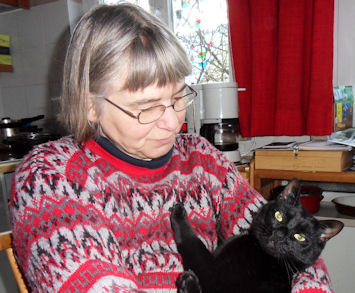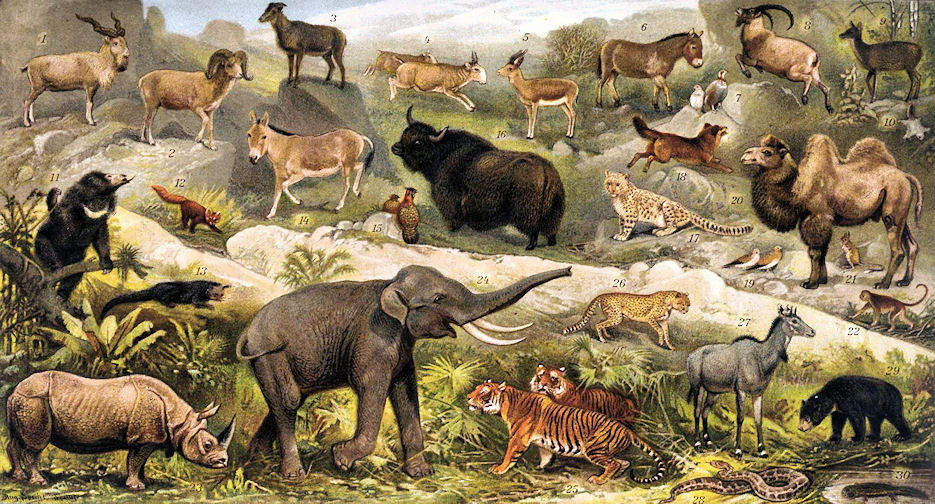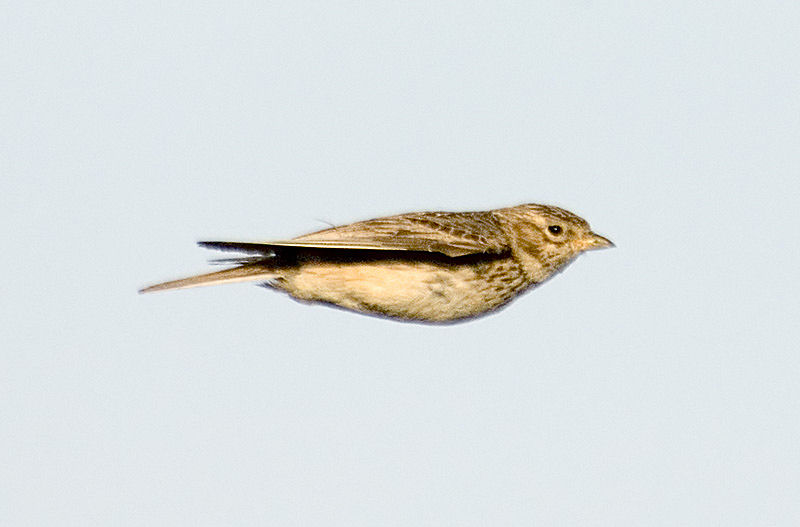16 cm
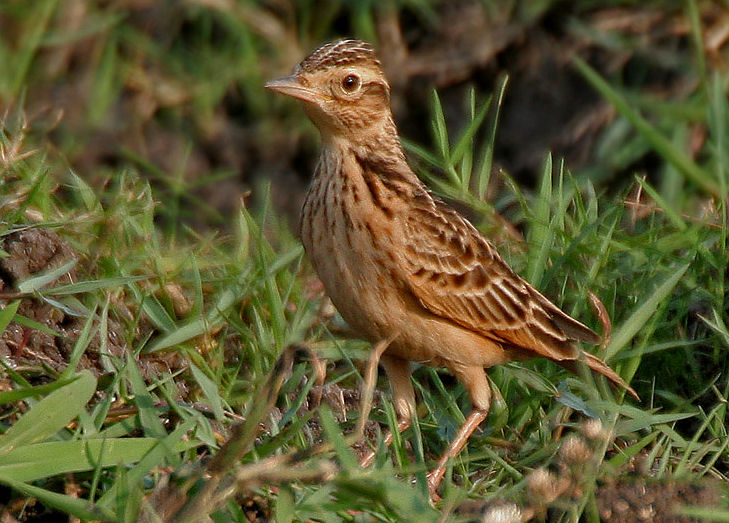
Abb.: भरद्वाजः । Alauda gulgula Franklin, 1831- Indian Small Skylark (Oriental
Skylark), Kolleru Lake - కొల్లేరు సరస్సు,
Andhra Pradesh
[Bildquelle: J. M. Garg / Wikimedia. -- GNU FDLicense]
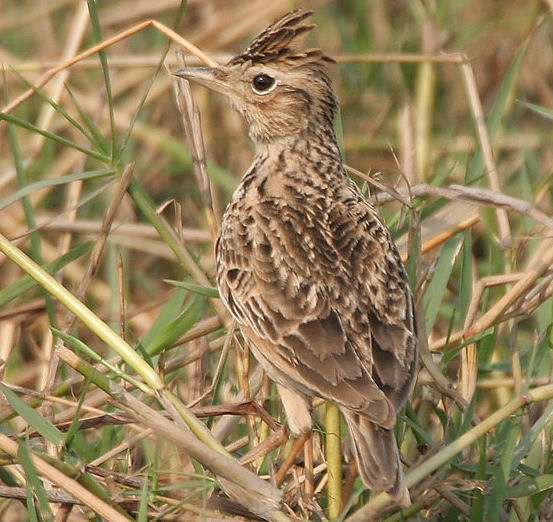
Abb.: भरद्वाजः । Alauda gulgula Franklin, 1831- Indian Small Skylark (Oriental
Skylark), Kolkata - কলকাতা,
West Bengal
[Bildquelle: J. M. Garg / Wikimedia. -- GNU FDLicense]
|
"Habitat. Throughout India to Cashmere and
Nepaul ; Sind, Kutch, Rajputana, N. Guzerat, Concan, Deccan, Beloochistan,
Afghanistan, Punjab, N.-W. Provinces and Cashmere. It is said by Blyth to occur
in Arracan. Gates found it abundant in Southern Pegu, and according to Dr.
Armstrong it is said to be spread over the whole Irrawady delta. Davison
observed it in the plains between the Sittangand Salween rivers and in the
immediate neighbourhood of Moulmein. It ranges throughout India, also the
Indo-Burmese countries, and Ceylon. Frequents cultivated lands. Breeds during
December. The nest is not unlike that of other larks, and is made in depressions
in the ground under the shelter of a stone or tuft of grass. Eggs 3 - 4, white,
or greyish-white mottled with brown. Eggs have been taken in the Nilgherries, in
the Central Provinces, Central India, Punjab, and N.-W. Provinces."
[Quelle: Murray, James
A.:
The avifauna of British India and its dependencies. -- London :
Trübner, 1888-1890. -- 2 Bde. -- Bd. 2, S. 360.] |
|
"The Indian Sky-lark is found throughout the
whole of India, frequenting grassy hills, meadows, and fields ; the grassy edges
of tanks are favorite spots, and also the bunds of rice fields, in which they
often breed. It rises into the air singing, but does not perhaps soar so high as
the Lavrock of England. It breeds from March to June, making its nest of grass
and hair, on the ground under a tuft of grass ; and laying three or four
greenish-grey eggs, with numerous brown and dusky streaks and spots. In the cold
weather they associate more or less in flocks, and are taken in great numbers
for the table. It is particularly abundant on the Neilgherries, and also in
Wynaad, and in Lower Bengal. I did not procure it at Darjeeling. "The song,"
says Mr. Blyth, "very closely resembles that of the British Sky-lark."
Comparatively few residents in India are
aware that a Skylark is common in almost every part of India, and when they go
to a hill station, observe this bird, perhaps for the first time, with equal
surprise and delight. About February many are brought to the Calcutta market,
and sold as Ortolan."
[Quelle:
Jerdon, T. C. (Thomas Claverhill) <1811-1872>: The birds
of India. -- Calcutta, 1862. -- Vol 2,1. -- S. 435.] |
Alauda arvensis Linnaeus, 1758 - (Eurasian) Skylark - Feldlerche
19 cm
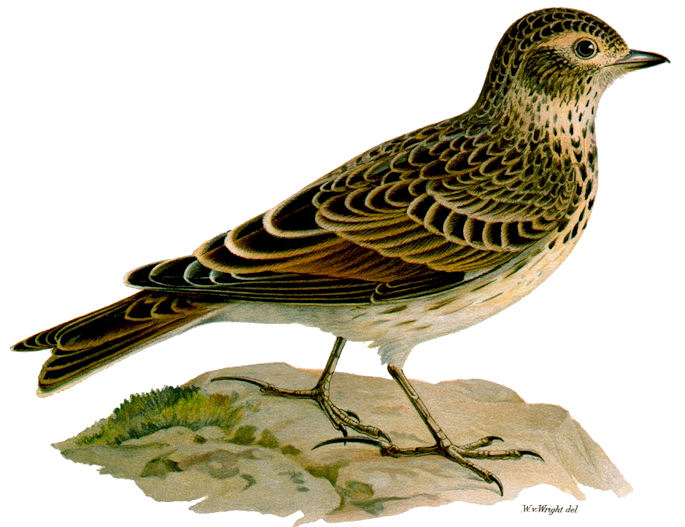
Abb.: भरद्वाजः । Alauda arvensis Linnaeus, 1758 - (Eurasian) Skylark -
Feldlerche
[Bildquelle: Wilhelm von Wright (1810 - 1887) / Wikipedia. -- Public domain]

भरद्वाजः । Klicken! Gesang von Alauda arvensis Linnaeus, 1758 - (Eurasian)
Skylark - Feldlerche
[Quelle der .ogg-Datei: Guido Gerding / Wikimedia. -- GNU FDLicense]
2.9.37. Motacilla sp. - Stelzen - Wagtails
|
15. c./d.
vyāghrāṭaḥ syād bharadvājaḥ
khañjarīṭas tu khañjanaḥ
व्याघ्राटः स्याद् भरद्वाजः खञ्जरीटस् तु खञ्जनः ॥१५ ख॥
[Bezeichnungen für
Motacilla sp. - Stelzen - Wagtails:]
- खञ्जरीट - khañjarīṭa m.: (zu khañj 1:
hinken) "yellow Wagtails : Motacilla flava, Yellow Wagtail (and
subspecies); Motacilla citreola, Yellow-headed Wagtail (Citrine
Wagtail); but may also designate white Wagtails." (Dave, 492)
- खञ्जन - khañjana m.: "Hinker" = "any of the
Passeridae, subfamily Motacillinae, genus Motacilla (Wagtail); white
Wagtail, esp. Motacilla alba, Pied Wagtail (White Wagtail) (and
subspecies." (Dave, 492)
|
Colebrooke (1807): "A wagtail."
Also u.a.:
-
Motacilla alba Linnaeus, 1758 - Pied Wagtail (White Wagtail) -
Bachstelze, und Unterarten
-
Motacilla flava Linnaeus, 1758 - Yellow Wagtail - Schafstelze,
und Unterarten
-
Motacilla citreola Pallas, 1776 - Yellow-headed Wagtail (Citrine
Wagtail) - Zitronenstelze
Motacilla alba Linnaeus, 1758 - Pied Wagtail (White Wagtail) -
Bachstelze, und Unterarten
18 cm
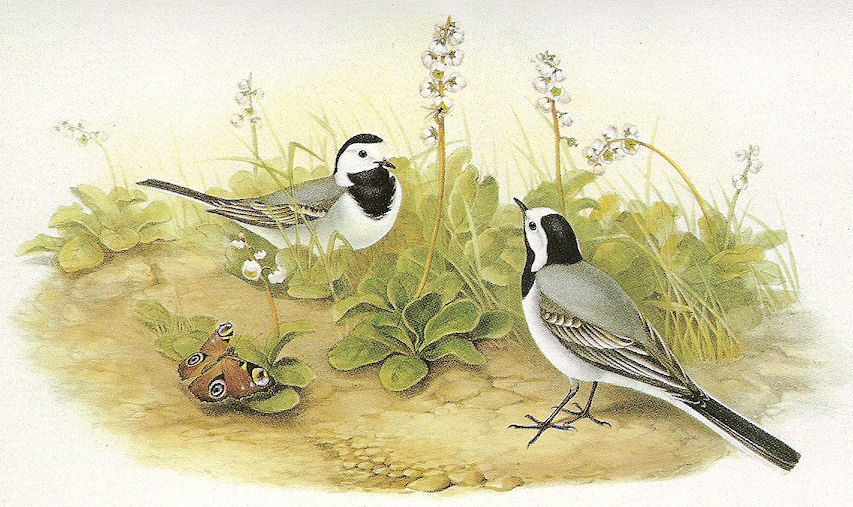
Abb.: खञ्जनः । Motacilla alba Linnaeus, 1758 - Pied Wagtail (White
Wagtail) - Bachstelze
[Bildquelle: Gould, Birds of Great Britain, 1862 - 1873]
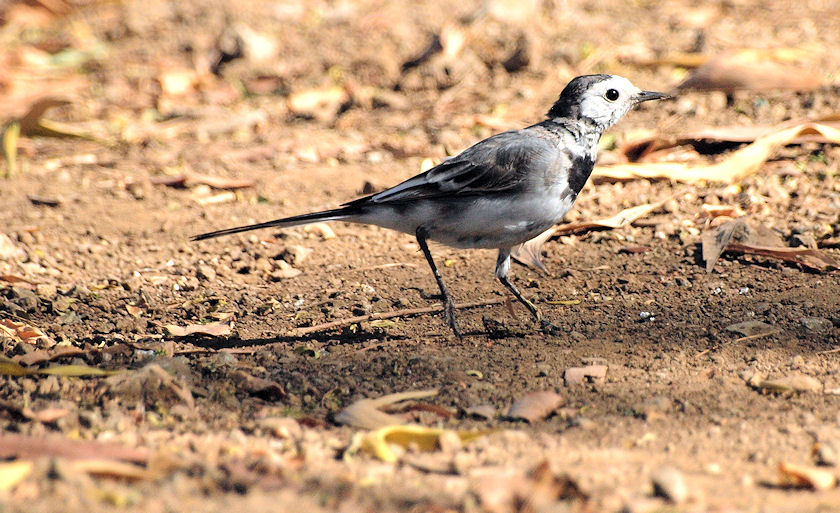
Abb.: खञ्जनः । Motacilla alba Linnaeus, 1758 - Pied Wagtail (White
Wagtail) - Bachstelze, Pune -
पुणे, Maharashtra
[Bildquelle:
Arun Prabhu. --
http://www.flickr.com/photos/29801206@N07/4358111847/. -- Zugriff am
2010-12-18. --
Creative Commons Lizenz (Namensnennung, keine Bearbeitung)]
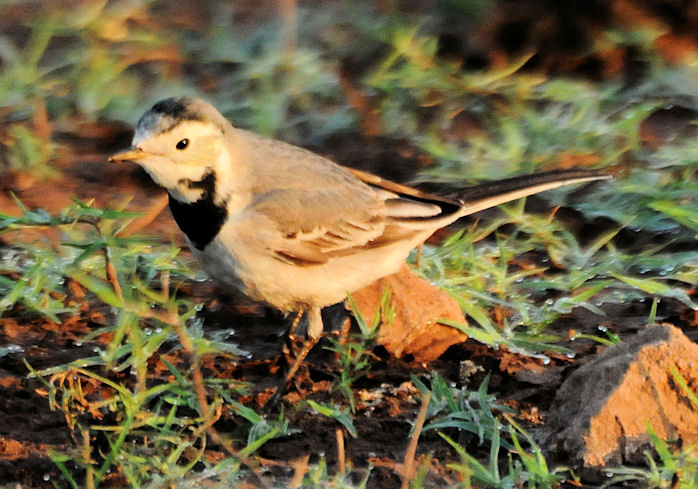
Abb.: खञ्जनः । Motacilla alba Linnaeus, 1758 - Pied Wagtail (White
Wagtail) - Bachstelze, Gujarat
[Bildquelle: Aditi-the-Stargazer. --
http://www.flickr.com/photos/aditithestargazer/3259576120/. -- Zugriff
am 2010-12-18. --
Creative
Commons Lizenz (Namensnennung, keine kommerzielle Nutzung, share alike)]
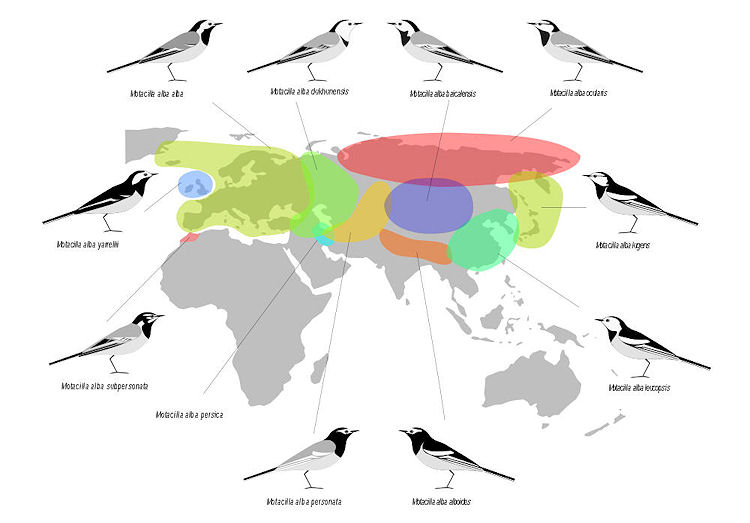
Abb.: खञ्जनः । Brutstätten von Motacilla alba Linnaeus, 1758 - Pied
Wagtail (White Wagtail) - Bachstelze, und Unterarten
[Bildquelle: L Shyamal / Wikipedia. --
Creative
Commons Lizenz (Namensnennung, share alike)]
|
"Habitat. The whole of Europe and Northern Asia,
wintering in N.-E. Africa and Senegambia, also the plains of India."
[Quelle: Murray, James
A.:
The avifauna of British India and its dependencies. -- London :
Trübner, 1888-1890. -- 2 Bde. -- Bd. 2, S. 272.] |
Motacilla flava Linnaeus, 1758 - Yellow Wagtail - Schafstelze,
und Unterarten
17 cm
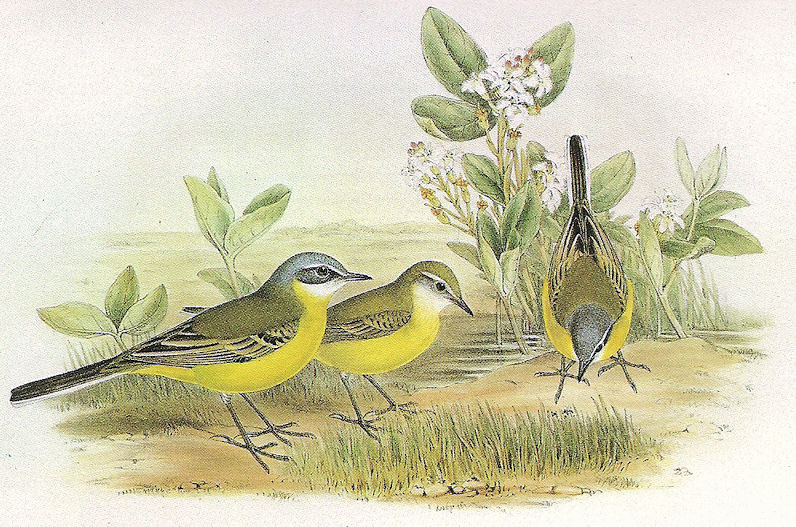
Abb.: खञ्जरीटः । Motacilla flava Linnaeus, 1758 - Yellow Wagtail -
Schafstelze
[Bildquelle: Gould, Birds of Great Britain, 1862 - 1873]
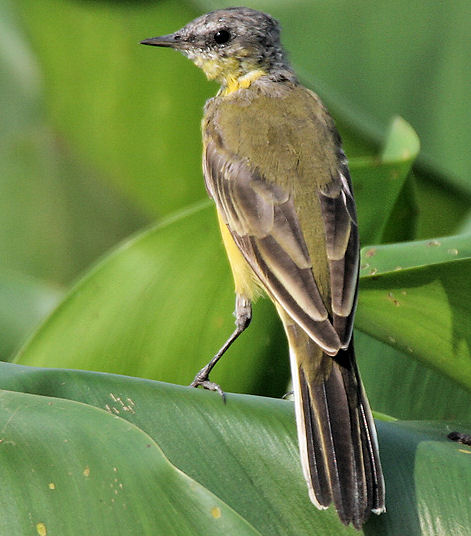
Abb.: खञ्जरीटः । Motacilla flava Linnaeus, 1758 - Yellow Wagtail -
Schafstelze, Kolkata - কলকাতা,
West Bengal
[Bildquelle: J. M. Garg / Wikimedia. -- GNU FDLicense]
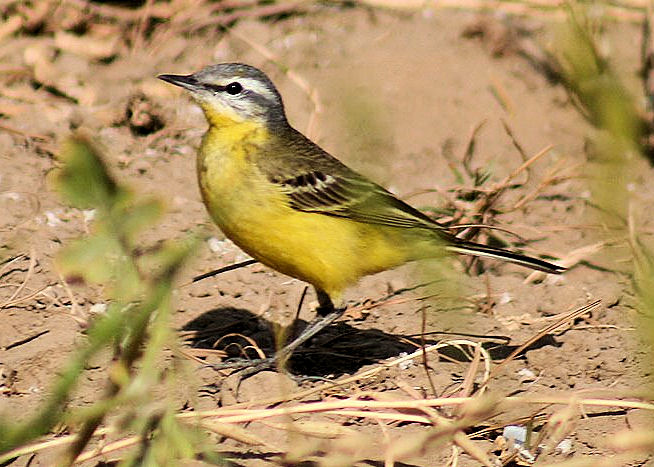
Abb.: खञ्जरीटः । Motacilla flava Linnaeus, 1758 - Yellow Wagtail -
Schafstelze, Hodal - होडाल, Haryana
[Bildquelle: J. M. Garg / Wikimedia. -- GNU FDLicense]
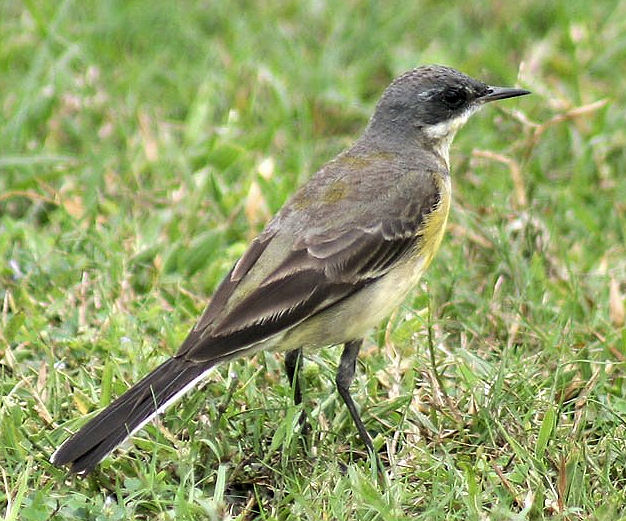
Abb.: खञ्जरीटः । Motacilla flava Linnaeus, 1758 - Yellow Wagtail -
Schafstelze, Hodal - होडाल, Haryana
[Bildquelle: J. M. Garg / Wikimedia. -- GNU FDLicense]
Motacilla citreola Pallas, 1776 - Yellow-headed Wagtail (Citrine
Wagtail) - Zitronenstelze
17 cm
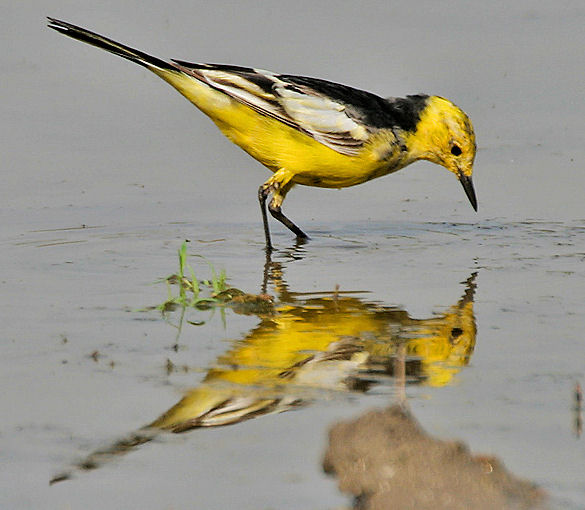
Abb.: खञ्जरीटः । Motacilla citreola Pallas, 1776 - Yellow-headed
Wagtail (Citrine Wagtail) - Zitronenstelze, Keoladeo National Park -
केवलादेव राष्ट्रीय उद्यान, Rajasthan
[Bildquelle: J. M. Garg / Wikimedia. -- GNU FDLicense]
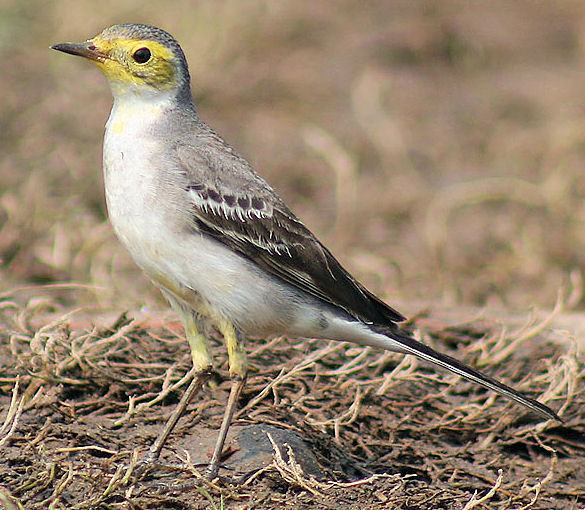
Abb.: खञ्जरीटः । Motacilla citreola Pallas, 1776 - Yellow-headed
Wagtail (Citrine Wagtail) - Zitronenstelze, Kolkata -কলকাতা,
West Bengal
[Bildquelle: J. M. Garg / Wikimedia. -- GNU FDLicense]
|
"Habitat. E. Europe, Africa ; Sind, Punjab,
N.-W. Provinces, Oudh, Bengal, Kutch, Kattiawar, Rajputana, Deccan ;
Beloochistan, Persia, Afghanistan, and E. Turkestan ; Nepaul, Gilgit, N.-W. and
Central India, Darjeeling, Assam and Bhamo. Breeds in Cashmere, where Mr.
Theobald found the nest placed in a depression in soft earth beneath a rock.
Eggs, four in number, pale grey, dotted with greyish brown."
[Quelle: Murray, James
A.:
The avifauna of British India and its dependencies. -- London :
Trübner, 1888-1890. -- 2 Bde. -- Bd. 2, S. 280.] |
|
"This species is remarkable for the great
length of the hind claw. It is found all over India in the cold weather, being
migratory, and probably breeding in North-Eastern Europe and Northern Asia. It
is not very abundant, and is never found in dry places like the last, but on the
banks of rivers and lakes, and more particularly in swampy ground, or in
inundated rice fields, apparently affecting concealment more than the others of
this group. It has been obtained in breeding plumage at Mussooree, and is then a
very beautiful bird."
[Quelle:
Jerdon, T. C. (Thomas Claverhill) <1811-1872>: The birds
of India. -- Calcutta, 1862. -- Vol 2,1. -- S. 226.] |
2.9.38. Haliastur indus Boddaert, 1783 - Brahminenweih - Brahmany
Kite
48 cm
|
16. a./b. lohapṛṣṭhas tu kaṅkaḥ syād
atha cāṣaḥ kikīdiviḥ
लोहपृष्ठस् तु कङ्कः स्याद् अथ चाषः
किकीदिविः
।१६ क।
[Bezeichnungen für
Haliastur indus Boddaert, 1783 - Brahminenweih - Brahmany Kite:]
-
लोहपृष्ठ - lohapṛṣṭha m.: "Rotrücken" = "Haliastur
indus, Brahmany Kite." (Dave, 509)
- कङ्क - kaṅka m.: Kaṅka = "Haliaeetus
leucoryphus, Pallas's Sea Eagle (Pallas's Fish Eagle) ; Ardea cinerea,
Grey Heron; Haliastur indus, Brahmany Kite." (Dave 486)
|
Colebrooke (1807): "A heron."
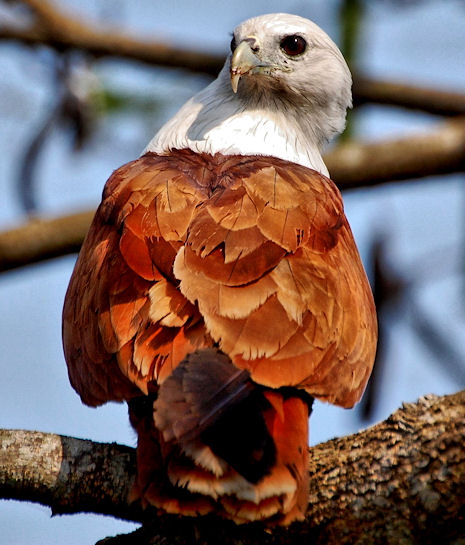
Abb.: लोहपृष्ठः । Haliastur indus Boddaert, 1783 - Brahminenweih -
Brahmany Kite, Chalakudy - ചാലക്കുടി, Kerala
[Bildquelle:
Challiyil Eswaramangalath Vipin. --
http://www.flickr.com/photos/11852045@N08/2209189778/. -- Zugriff am
2010-12-18. --
Creative Commons Lizenz (Namensnennung, share alike)]
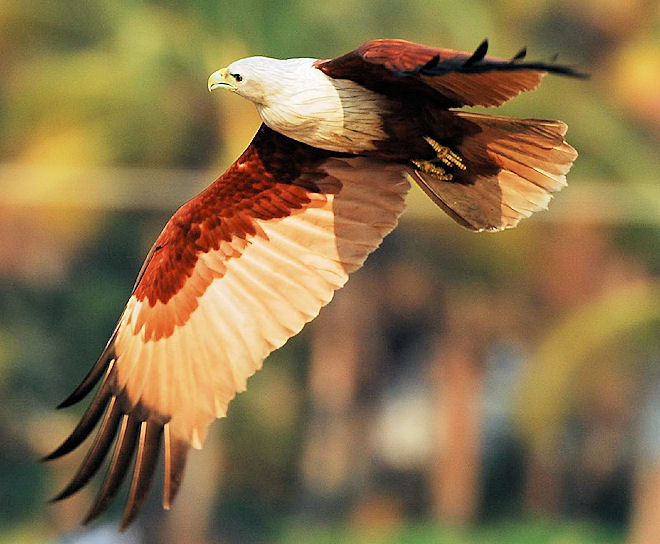
Abb.: लोहपृष्ठः । Haliastur indus Boddaert, 1783 - Brahminenweih -
Brahmany Kite, Chalakudy - ചാലക്കുടി, Kerala
[Bildquelle:
Challiyil Eswaramangalath Vipin. --
http://www.flickr.com/photos/11852045@N08/2281826702/. -- Zugriff am
2010-12-18. --
Creative Commons Lizenz (Namensnennung, share alike)]
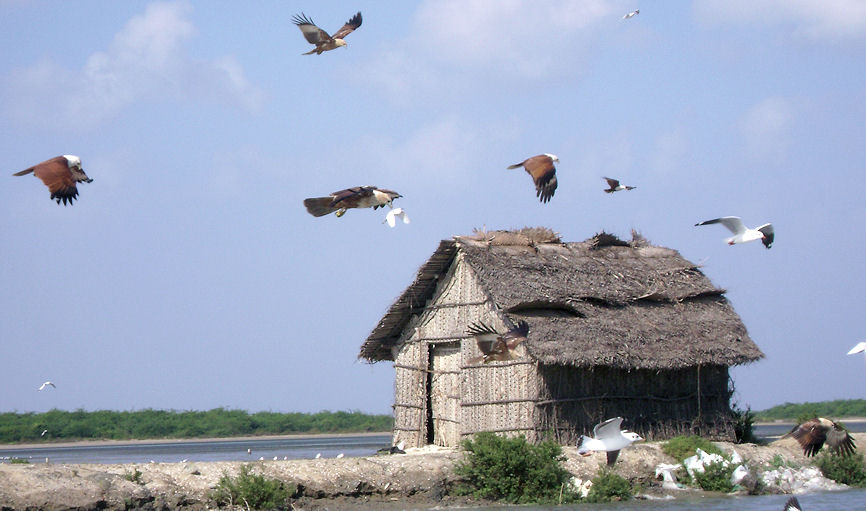
Abb.: लोहपृष्ठाः । Haliastur indus Boddaert, 1783 - Brahminenweih -
Brahmany Kite und Möwen, Point Calimere (கள்ளி மேடு) Wildlife and Bird Sanctuary,
Tamil Nadu
[Bildquelle: Marcus334 / Wikipedia. -- GNU FDLicense]
|
"Habitat. India and Ceylon. Recorded from
Sind, the Punjab, N.-W. Provinces, Kutch, Kattiawar, Ajmere, Concan, Deccan,
Tranvancore, Upper Pegu, Nepal. Breeds wherever it occurs from the middle of
February to the beginning of April, The nest is always on a tree near by water,
and is not unlike that of Milvus govinda. The normal number of eggs is two, but
it is not uncommon to find three. In shape they vary much ; but typically they
are very perfect, moderately broad ovals, slightly compressed towards one end ;
in colour greyish white, speckled or spotted with pale dingy brown or reddish
brown."
[Quelle: Murray, James
A.:
The avifauna of British India and its dependencies. -- London :
Trübner, 1888-1890. -- 2 Bde. -- Bd. 1, S. 56.] |
|
"The Brahminy Kite is found throughout all
India, abundant on the sea coasts, and in the vicinity of lakes and wet
cultivation ; rare in the dry plains of Central India and the Deccan. Colonel
Sykes says that it "usually seizes whilst on the wing, but occasionally dips
entirely under water, appearing to rise again with difficulty." This I have
never witnessed, nor has any one I have questioned on the subject, and their
name is legion. He also says, "it is quite a mistake to suppose it feeds on
carrion." Mr. Smith, as quoted in Notes on Indian Birds, P. Z. S., 1857, p. 85,
says—"This bird is among the first objects which attracts the eye of a stranger,
for they swarm about the shipping at Calcutta, and are useful in removing any
offal which may be thrown away ; but though their usual food is carrion, yet
they kill fish, and not unfrequently carry off a snipe which the sportsman has
levelled." Hodgson says, it chiefly feeds on insects and quests like a Circus.
From my own observations it certainly prefers aquatic food, and is most numerous
in the vicinity of sea-shores, large rivers, tanks, and rice cultivation. About
large cities and towns, and where there is much shipping, it gets its chief food
from garbage and offal thrown overboard, or, occasionally, from what is thrown
out in the streets and roads. Near large rivers or lakes it manages to pick off
the surface of the water small fishes, or a prawn occasionally ; but its chief
food, away from towns and cantonments, is frogs, and crabs, which abound in all
rice fields, and the remains of which last, picked clean, may be found so
abundantly along the little bunds that divide the fields from each other. It
will also eat water insects, mice, and shrews, and young or sickly birds ; and
many a wounded snipe I have seen carried off by the Brahminy Kite. In wooded
countries I have seen it questing over the woods, and catching insects,
especially large Cicadas, and I have also seen it whip a locust off standing
grain. Now and then it gives hot chase to a crow, or even to a common kite, and
forces them to give up some coveted piece of garbage or dead fish; when thus
employed, it exhibits considerable speed and great energy. It is much on the
wing, soaring lazily about cantonments, or up and down rivers; but after a time
seats itself on some palm or other tree, on the mast of a ship, and even on the
ground. Near cities it is very tame and fearless, and I have often seen one
catching fish thrown up to it by some pious Hindoo. It is said sometimes to
carry off young chickens and pigeons, but I have not myself witnessed this. If
the food it has seized be small, it devours it as it flies; but if large, it
generally sits down on the ground, or the bund of a paddy field, or carries it
off to a lofty tree.
The Brahminy Kite breeds on trees, in
February and March, making a not very large nest of sticks, sometimes lined with
mud, and laying generally only two eggs, which are sometimes dirty white, at
other times white, with a few rusty brown spots. In the Carnatic it usually
selects a palm tree to build in. Layard says that it makes several false nests,
and that, whilst the female is incubating, the male generally occupies one of
the nests first made.
It has a peculiar, rather wild, squeal ; but
it is not so noisy a bird as its more plebeian relation, the pariah-kite. It is,
as is well known, sacred to Vishnu ; hence the name of Brahminy Kite given it by
Europeans in India. The Mussulman name Rumbarik, or lucky face, arises from an
idea that when two armies are about to engage the appearance of one of these
birds over either party prognosticates victory to that side."
[Quelle:
Jerdon, T. C. (Thomas Claverhill) <1811-1872>: The birds
of India. -- Calcutta, 1862. -- Vol 1. -- S. 102ff.] |
2.9.39. Coraciidae - Racken - Roller
|
16. a./b. lohapṛṣṭhas tu kaṅkaḥ syād
atha cāṣaḥ kikīdiviḥ
लोहपृष्ठस् तु कङ्कः स्याद् अथ चाषः
किकीदिविः ।१६ क।
[Bezeichnungen für
Coraciidae - Racken - Roller:]
-
चाष - cāṣa m.: Cāṣa = "all Coraciidae (Roller) :
Coracias benghalensis, Indian Roller ; Coracias garrulus, European
Roller ; Eurystomus orientalis,
Broad-billed Roller (Dollarbird)." (Dave, S. 495)
-
किकीदिवि - kikīdivi m.: Kikīdivi = Coracias
benghalensis, Indian Roller ; Pelargopsis capensis, (Brown-headed)
Stork-billed Kingfisher ; Halycon smyrnensis, White breasted
Kingfischer." (Dave, 488)
|
Colebrooke (1807): "A blue jay. Coracias Indica and
Bengalensis ; or as otherwise explained, a different bird."
d.h. u. a.:
-
Coracias benghalensis Linnaeus, 1758 - Indian Roller - Hinduracke
-
Coracias garrulus Linnaeus, 1758 - European Roller - Blauracke
-
Eurystomus orientalis Linnaeus, 1766 - Broad-billed Roller (Dollarbird)
- Dollarvogel
Evtl. auch:
-
Pelargopsis capensis Linnaeus, 1766 - (Brown-headed)
Stork-billed Kingfisher - Storchschnabelliest
-
Halcyon smyrnensis Linnaeus, 1758 - White breasted
Kingfischer - Braunliest
Coracias benghalensis Linnaeus, 1758 - Indian Roller -
Hinduracke
31 cm
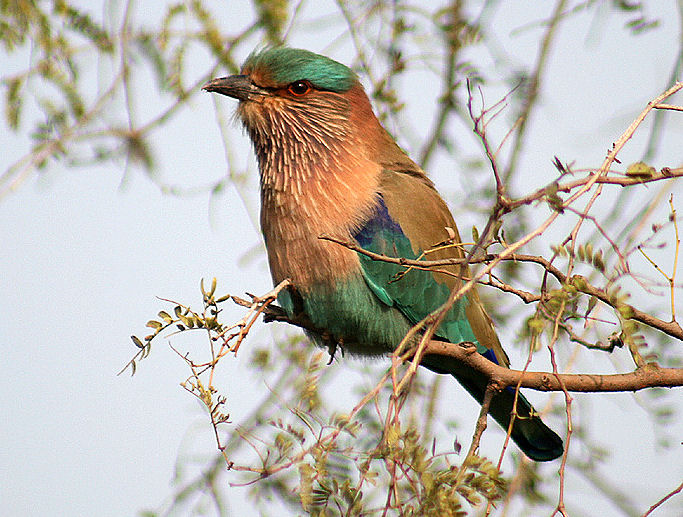
Abb.: चाषः । Coracias benghalensis Linnaeus, 1758 - Indian Roller
- Hinduracke, Bharatpur - भरतपुर,
Rajasthan
[Bildquelle: J. M. Garg / Wikimedia. -- GNU FDLicense]
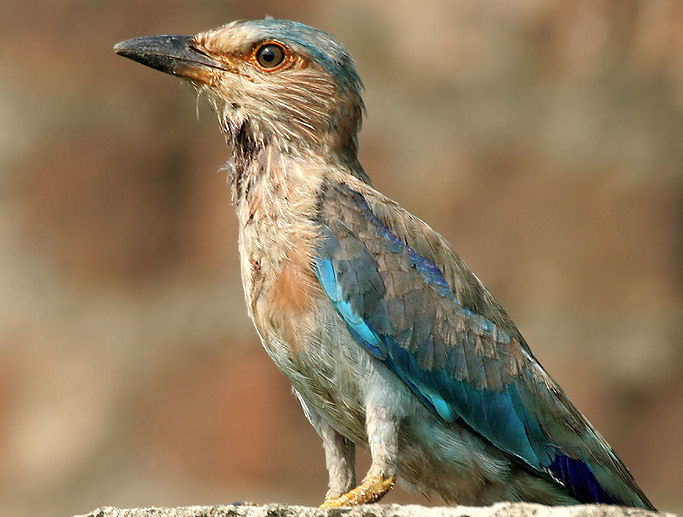
Abb.: चाषः । Coracias benghalensis Linnaeus, 1758 - Indian Roller
- Hinduracke, Kolkata -
কলকাতা, West Bengal
[Bildquelle: J. M. Garg / Wikimedia. -- GNU FDLicense]
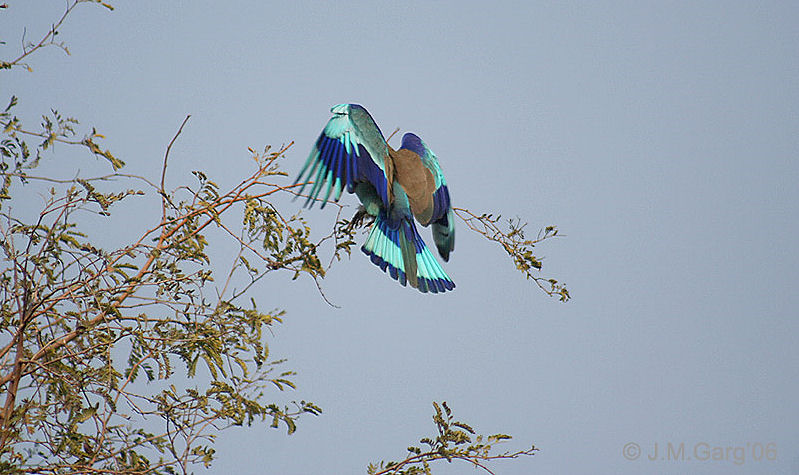
Abb.: चाषः । Coracias benghalensis Linnaeus, 1758 - Indian Roller
- Hinduracke, Bharatpur - भरतपुर,
Rajasthan
[Bildquelle: J. M. Garg / Wikimedia. -- GNU FDLicense]
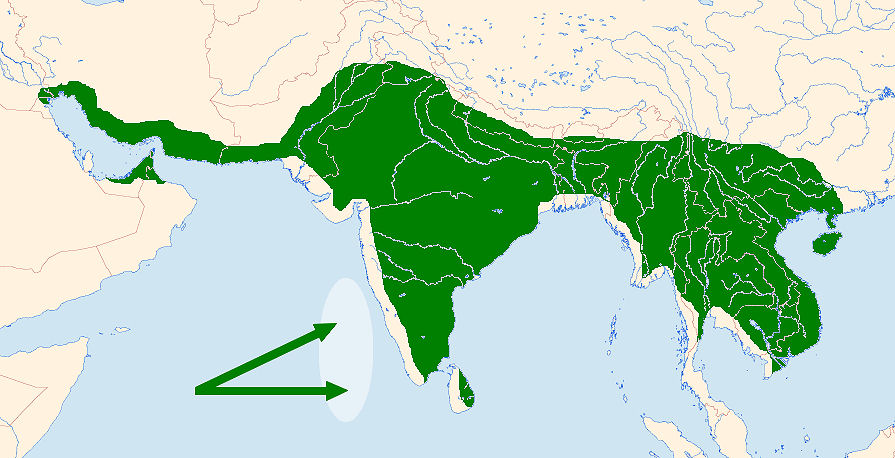
Abb.: चाषः । Lebensraum von Coracias benghalensis Linnaeus, 1758
- Indian Roller - Hinduracke
[Bildquelle: Ulrich prokop / Wikimedia. -- GNU FDLicense]
|
"Habitat. The whole of India and Ceylon ; the
Himalayas, Nepaul, N.-W. Provinces, the Punjab, Sind, S. Persia (Bushire),
Beloochistan, Kutch, Kattiawar, Jodhpore, Jeypore, North Guzerat, the Concans
and the Deccan. In Sind it is a resident and breeds in holes of decayed trees,
and sometimes in the deep forks of acacia trees, in April and May. Eggs two in
number, round, pure white."
[Quelle: Murray, James
A.:
The avifauna of British India and its dependencies. -- London :
Trübner, 1888-1890. -- 2 Bde. -- Bd. 2, S. 476.] |
|
"The Indian Roller is distributed throughout
the whole of India, from Ceylon and Cape Comorin to the base of the Himalayas ;
towards the North-east of our limits it begins to disappear, and is replaced by
the next species, and in the extreme North-west its place is taken by C. garrula
of Europe and Western Asia. Adams asserts that it is also found in Ladakh and
Tibet, and he ignores the existence of C. garrula in the North-west.
It frequents alike open jungles, groves,
avenues, gardens, clumps of trees in the open country, and, except in thick
forest, is to be found everywhere, and is sure to be met with about every
village. It generally takes its perch on the top, or outermost branch, of some
high tree, and, on spying an insect on the ground, which it can do at a very
great distance, it flies direct to the spot, seizes it, and returns to its perch
to swallow it. A favourite perch of the Roller is a bowrie pole, or some
leafless tree whence it can see well all around ; also old buildings, a
haystack, or other elevated spot; sometimes a low bush, or a heap of earth, or
of stones. When seated it puffs out the feathers of its head and neck. I have,
on several occasions, seen one pursue an insect in the air for some distance,
and when the winged termites issue from their nest after rain, the Roller, like
almost every other bird, catches them on the wing. It flies in general with a
slow, but continued, flapping of its wings, not unlike the Crow, though more
buoyant ; but it has the habit of occasionally making sudden darts in the air in
all directions. Its food is chiefly large insects, grass-hoppers, crickets,
mantidae, and even beetles ; occasionally a small field-mouse, or shrew.
It is often caught by a
contrivance, called the Chou-gaddi. This consists of two thin pieces
of cane, or bamboo, bent down at right angles to each other to form
a semicircle, and tied in the centre. To the middle of this the bait
is tied, usually a mole cricket, sometimes a small field mouse, (Mus
lepidus) ; the bait is just allowed tether enough to move about in a
small circle. The cane is previously smeared with bird-lime, and it
is placed on the ground, not far from the tree where the bird is
perched. On spying the insect moving about, down swoops the Roller,
seizes the bait, and on raising its wings to start back, one, or
both, are certain to be caught by the viscid bird-lime. By means of
this very simple contrivance, many birds that descend to the ground
to capture insects are taken, such as the King-crows (Dicruri),
common Shrikes, some Thrushes, Fly-catchers, and even the large
Kingfishers (Halcyon).
The Roller has a very harsh grating cry or
scream, which it always utters when disturbed, and often at other times also.
Mr. Blyth states that in spring the male has a pleasing dissyllabic cry,
repeated at intervals : this I cannot say I have heard. As previously mentioned,
it is often selected as the quarry for the Turumti Falcon (Falco chicquera), and
its extraordinary evolutions to escape the hawk, and its harsh cries, are
noticed under the description of that falcon.
It breeds towards the end of the hot weather
and beginning of the rains, in holes of trees, old walls, old pagodas, laying
three or four round rather pure white eggs. Tickell says that they are four or
five, full deep antwerp-blue. In this case a Myna's eggs were probably brought
to him, as that bird builds in similar places, and its eggs are blue. What eggs
Layard can have got as those of the Roller I am at a loss to imagine ; he
describes the eggs as greenish, profusely speckled with dark brown spots, taken
from hollow trees. Captain Irby says that it breeds in the roofs of houses in
Oudh, as well as in holes of trees, and that it sometimes makes a hole for its
nest in the thatch of bungalows. I have not seen it so familiar in the south of
India, but Adams also states that it breeds in the thatch of bungalows, and in
chimneys. Does not he refer to the Coracias garrula ? It is very quarrelsome and
pugnacious in the breeding season.
The Nilkant is sacred to Siva, who assumed
its form ; and at the feast of the Dasserah, at Napgore, one, or more, used to
be liberated by the Rajah, amidst the firing of cannon and musketry, at a grand
parade attended by all the officers of the station.
Buchanan Hamilton also states that before the
Durga Puja, the Hindoos of Calcutta purchase one of these birds, and at the time
when they throw the image of Durga into the river, set the Nilkant at liberty.
It is considered propitious to see it on this day, and those who cannot afford
to buy one, discharge their matchlocks to put it on the wing.
The Telugu name of the Roller,
signifying Milk-bird, is given because it is supposed that when a
cow gives little milk, if a few of the feathers of this bird are
chopped up and given along with grass to the cow, the quantity will
greatly increase. It is one of the birds on whose movements many
omens depend. If it cross a traveller just after starting, it is
considered a bad omen."
[Quelle:
Jerdon, T. C. (Thomas Claverhill) <1811-1872>: The birds
of India. -- Calcutta, 1862. -- Vol 1. -- S. 215ff.] |
Coracias garrulus Linnaeus, 1758 - European Roller - Blauracke
31 cm
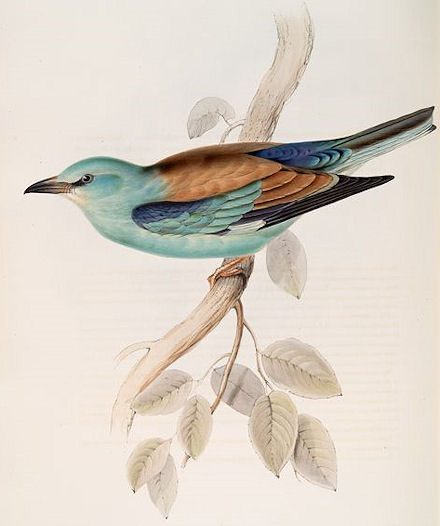
Abb.: चाषः । Coracias garrulus Linnaeus, 1758 - European Roller -
Blauracke
[Bildquelle: John Gould, 1832 / Wikipedia. -- Public domain]
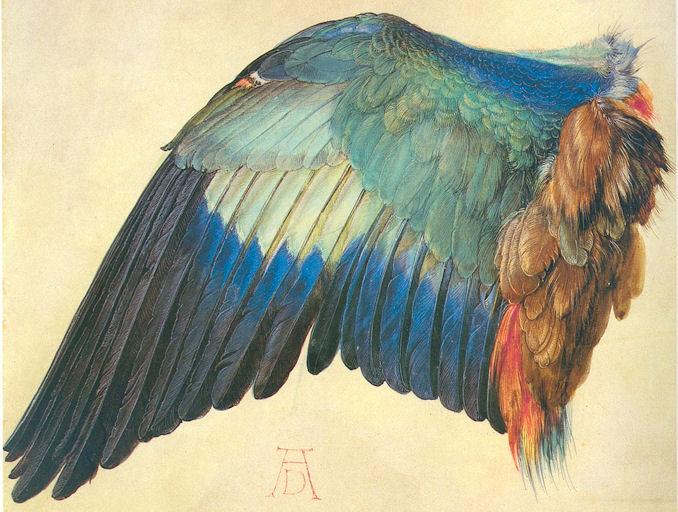
Abb.: चाषः । Albrecht Dürer: Flügel einer Blauracke, 1512
[Bildquelle: Wikimedia. -- Public domain]
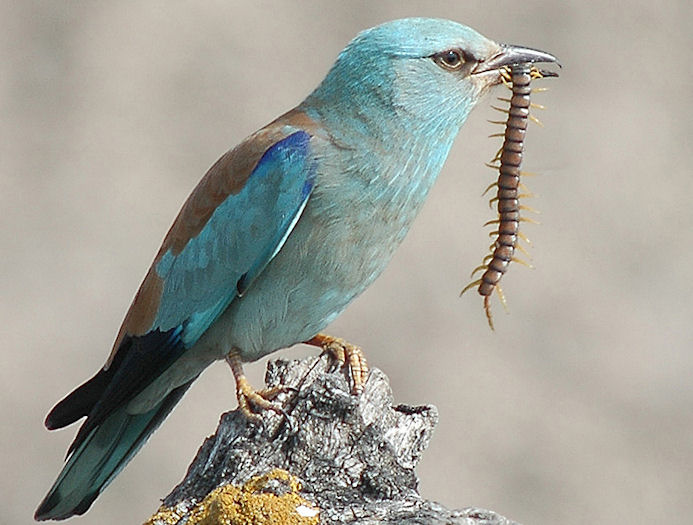
Abb.: चाषः । Coracias garrulus Linnaeus, 1758 - European Roller -
Blauracke, Estremadura, Spanien
[Bildquelle: Christian Svane / Wikipedia. --
Creative Commons Lizenz (Namensnennung, share alike]
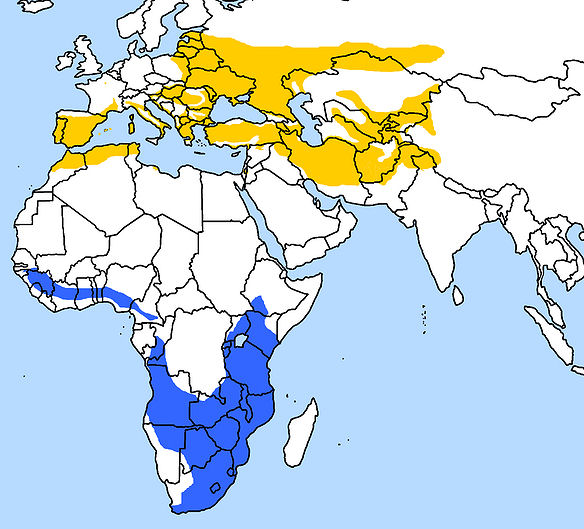
Abb.: चाषः । Brutgebiete (gelb) und Überwinterungsgebiete von
Coracias garrulus Linnaeus, 1758 - European Roller - Blauracke
[Bildquelle: Scops / Wikipedia. -- GNU FDLicense]
|
"Habitat. Central and South Europe,
Madagascar, Egypt, Arabia, Persia, N.-E. Africa, Western and Central Asia. It is
said to breed in Persia, Afghanistan, and Turkistan. In Beloochistan, Punjab,
N.-W. Provinces and Sind it occurs as a migrant."
[Quelle: Murray, James
A.:
The avifauna of British India and its dependencies. -- London :
Trübner, 1888-1890. -- 2 Bde. -- Bd. 2, S. 476.] |
|
"The European Roller is only found, in our
province, in the extreme North-west; and even there (it would seem) but rarely.
It has been taken at Moultan, and in other parts of the Punjab, also in
Cashmere. It is common in Western and Central Asia, and Northern Africa, and is
said to breed usually in holes of trees, but sometimes in holes in river banks,
laying two pure-white eggs. Pallas says that, in Central Asia, it feeds chiefly
on beetles, and often fights with the Magpie."
[Quelle:
Jerdon, T. C. (Thomas Claverhill) <1811-1872>: The birds
of India. -- Calcutta, 1862. -- Vol 1. -- S. 218f.] |
Eurystomus orientalis Linnaeus, 1766 - Broad-billed Roller
(Dollarbird) - Dollarvogel
31 cm
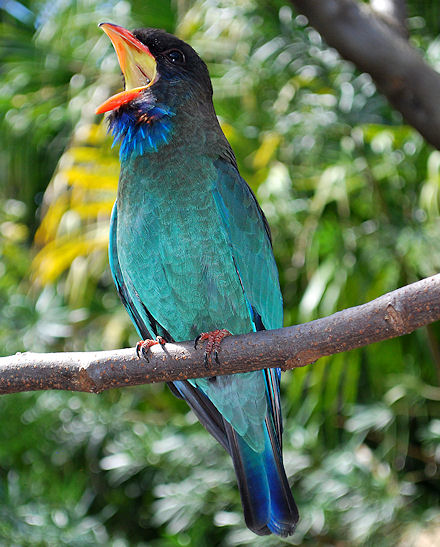
Abb.: चाषः । Eurystomus orientalis Linnaeus, 1766 - Broad-billed
Roller (Dollarbird) - Dollarvogel, Zoo
[Bildquelle: divemasterking2000. --
http://www.flickr.com/photos/15775662@N00/4507826657. -- Zugriff am
2010-12-18. --
Creative
Commons Lizenz (Namensnennung)]
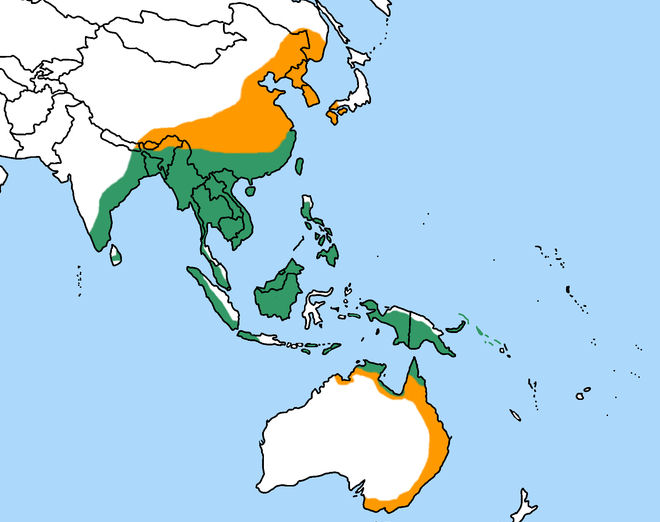
Abb.: चाषः । Lebensräume von Eurystomus orientalis Linnaeus, 1766
- Broad-billed Roller (Dollarbird) - Dollarvogel: grün: Jahresvogel;
gelb: Brutvogel
[Bildquelle: Ulrich Prokop / Wikipedia. -- GNU FDLicense]
|
"Habitat. The base of the Himalayas, Lower
Bengal, Assam, the Burmese countries, extending to China, Ceylon, Siam,
Cochin-China, and down the Malay Peninsula to Sumatra, Java, and Borneo.
According to Gates, it is rare, though locally distributed over the greater part
of Burmah. It has been got in Pegu, in the hills north of that town, also at
Tonghoo and at Shwaygheen. Capt. W. Ramsay got it on the Karin hills, and Mr.
Blanford at Bassein, and Davison's experience is that it is confined to the
southern portion of Tenasserim. Gates adds that it is almost crepuscular in its
habits. It breeds in the Terai during May in holes of the higher branches of
lofty trees. Nothing appears to be known of its eggs, but they also are probably
white."
[Quelle: Murray, James
A.:
The avifauna of British India and its dependencies. -- London :
Trübner, 1888-1890. -- 2 Bde. -- Bd. 2, S. 477.] |
|
"This handsome Roller is found at the base of
the Himalayas, in Lower Bengal, Assam, and the Burmese countries, extending to
Ceylon, Malayana, and China. It has not yet been met with in Southern India ;
but I heard of a species of Roller which ray Shikarees called the Pindarya
nilkant, which could have been no other than this bird. It was said to visit
Central India, occasionally, in the cold weather. This Roller is stated to take
its prey more on the wing than the common Rollers, and keeps much to the thick
and lofty forests, though occasionally found in well-wooded regions, as about
Calcutta. Layard says that it clings to trees like a Woodpecker, and that he saw
it tearing away the decayed wood round a hole in a dead tree. "Their stomachs
were," says he, " full of wood-boring Coleoptera, swallowed whole, merely a
little crushed ; and I saw them beat their food against the trees." These are
rather anomalous habits for a Roller."
[Quelle:
Jerdon, T. C. (Thomas Claverhill) <1811-1872>: The birds
of India. -- Calcutta, 1862. -- Vol 1. -- S. 219f.] |
Pelargopsis capensis Linnaeus, 1766 - (Brown-headed)
Stork-billed Kingfisher - Storchschnabelliest
38 cm
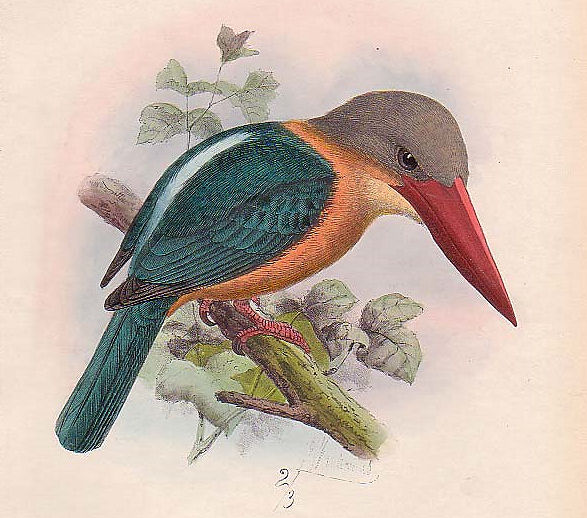
Abb.: किकीदिविः । Pelargopsis capensis Linnaeus, 1766 -
(Brown-headed) Stork-billed Kingfisher - Storchschnabelliest
[Bildquelle: Keulemans 1868 / Wikipedia. -- Public domain]
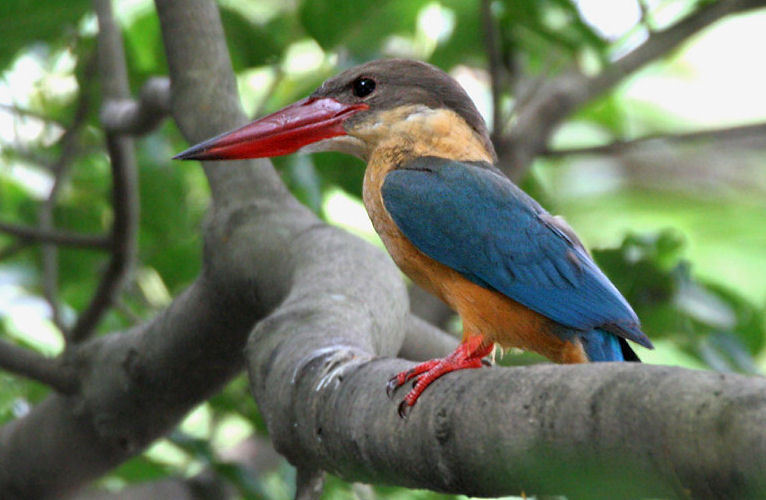
Abb.: किकीदिविः । Pelargopsis capensis Linnaeus, 1766 -
(Brown-headed) Stork-billed Kingfisher - Storchschnabelliest, Kolkata -
কলকাতা, West Bengal
[Bildquelle: J. M. Garg / Wikimedia. -- GNU FDLicense]
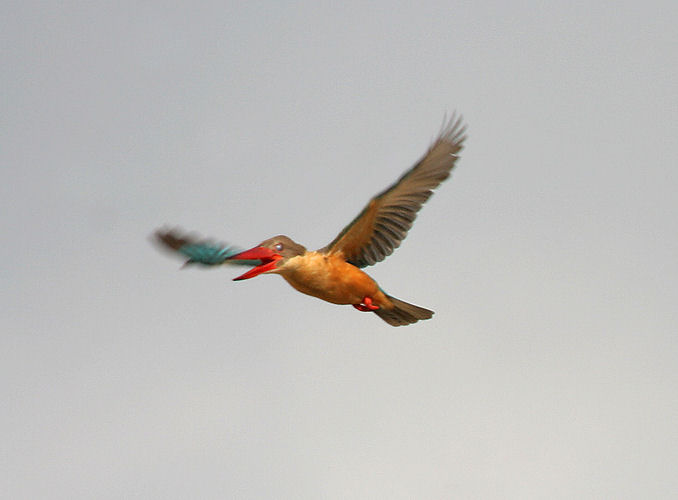
Abb.: किकीदिविः । Pelargopsis capensis Linnaeus, 1766 -
(Brown-headed) Stork-billed Kingfisher - Storchschnabelliest, Kolkata -
কলকাতা, West Bengal
[Bildquelle: J. M. Garg / Wikimedia. -- GNU FDLicense]
|
"Habitat. Southern India and Ceylon to Bengal
and the Himalayas, affecting well-wooded forests. In Malabar Jerdon says it is
common; rare in the Carnatic ; found occasionally in Central India and the
Northern Circars. Breeds in the lower Himalayas during June. Eggs, 4 in number,
round, pure white ; size 1.09 x 1.02 inch."
[Quelle: Murray, James
A.:
The avifauna of British India and its dependencies. -- London :
Trübner, 1888-1890. -- 2 Bde. -- Bd. 2, S. 487.] |
|
"This large Kingfisher is found over all
India, from the extreme South, and Ceylon, to Bengal ; but only is general where
there is much jungle or forest, or where the banks of rivers are well wooded. It
is common in Malabar ; rarely seen in the Carnatic and upon the Table Land ;
occasionally found in Central India and the Northern Circars ; and most abundant
in Bengal, but apparently not found, or rare, in the North-west. It extends
likewise to all the countries east of the Bay of Bengal, even to the islands of
Malayana, but varying slightly from the peninsular bird.
[...]
Our bird is found along rivers, streams, and
back-waters ; but only where tolerably well shaded by trees. It sits on a branch
overhanging the water, and pounces on fish, crabs, and occasionally frogs. It
has rather a peculiar call (peer peer pur), several times repeated. Layard,
however, calls it a loud, harsh note, not unlike the cracking of castanets.
It is said to build in hollow trees, or in
holes in mud-walls. Mr. Smith, as quoted in Horsfield's Catalogue, says that he
once observed a contest between a bird of this species and a Hawk of
considerable size, in which the latter was worsted and obliged to leave his
hold, from the effects of a severe blow which the other administered to him on
the breast."
[Quelle:
Jerdon, T. C. (Thomas Claverhill) <1811-1872>: The birds of India. --
Calcutta, 1862. -- Vol 1. -- S. 223.]
|
Halcyon smyrnensis Linnaeus, 1758 - White breasted Kingfischer
- Braunliest
28 cm
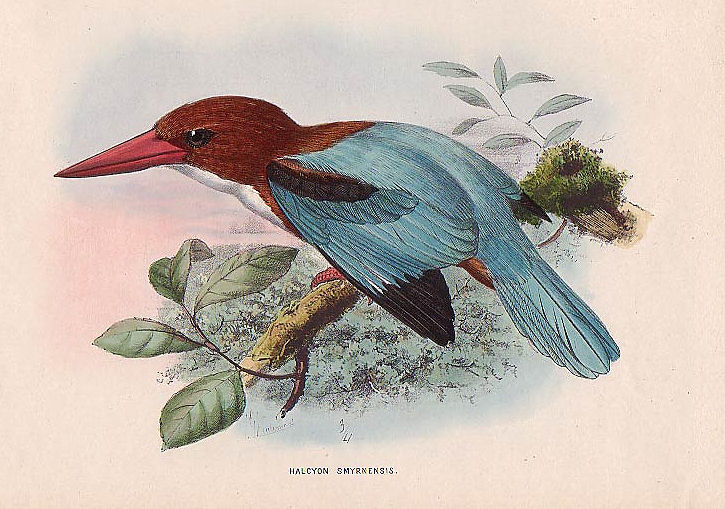
Abb.: किकीदिविः । Halcyon smyrnensis Linnaeus, 1758 - White
breasted Kingfischer - Braunliest
[Bildquelle: Keulemans 1868 / Wikipedia. -- Public domain]
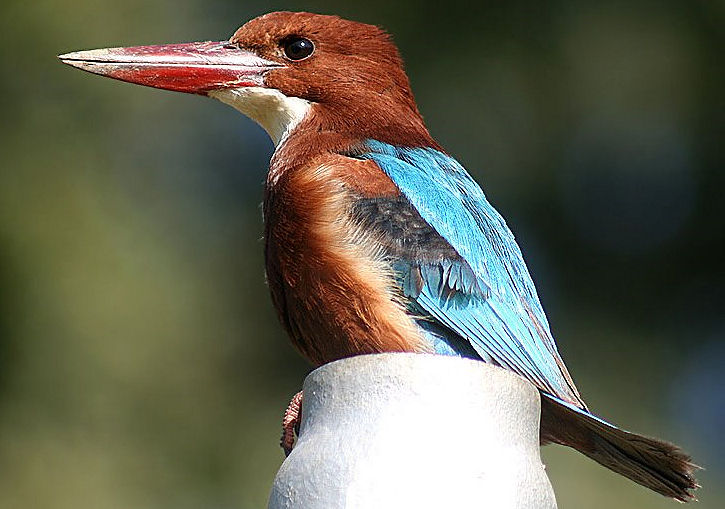
Abb.: किकीदिविः । Halcyon smyrnensis Linnaeus, 1758 - White
breasted Kingfischer - Braunliest, Bharatpur -
भरतपुर, Rajasthan
[Bildquelle: J. M. Garg / Wikimedia. -- GNU FDLicense]
|
"Habitat. The Peninsula of India and Ceylon
to the base of the Himalayas, extending to the Indo-Burmese countries, Singapore
and China. Recorded from the Concans and Deccan, Kutch, Kattiawar, Jodhpore,
Sambur, N. Guzerat, Travancore and Nepaul. Breeds all over India nearly, from
March to July, laying 4 - 7 eggs in a hole excavated by itself in banks of
tanks, and canals or streams, also in the interior of wells, or on cliffs
overlooking rivers. Eggs spherical ; some are slightly oval. Like those of its
congeners, they are pure white. In length they vary from 1.05 to 1.27 inch and
in breadth from 0.97 to 1.12 inch."
[Quelle: Murray, James A.:
The avifauna of British India and its dependencies. -- London : Trübner,
1888-1890. -- 2 Bde. -- Bd. 2, S. 483.]
|
|
"This well-known Kingfisher is very abundant
in most parts of India, and is found throughout the whole peninsula and Ceylon,
up to the base of the Himalayas, and extending through all the countries to the
east, as far as China.
It prefers a wooded country, but is not found
in thick forests ; and is to be met with about most large villages and
cantonments. It frequents banks of rivers and brooks, edges of tanks, as also
the neighbourhood of wells and wet paddy-fields ; but it is as frequently found
away from water, in groves of trees, gardens, open jungle, and dry cultivation ;
perching upon trees, poles, walls, old buildings, and any similar situation.
Here it watches for a land-crab, mouse, lizard, grasshopper, or other insect ;
and pounces down on it, returning to its perch to devour it. Near water it
catches fish (for which it sometimes though rarely dives), frogs, tadpoles, and
water-insects. Layard states that he has seen it seizing butterflies. It has a
loud, harsh, rattling scream, which it almost always utters when flying. It is
stated to build its nest sometimes under a projecting stone on the bank of a
nullah ; sometimes in a hole in a bank ; at other times in holes in decaying
trees; and to lay from 2 to 7 round fleshy-white eggs."
[Quelle:
Jerdon, T. C. (Thomas Claverhill) <1811-1872>: The birds
of India. -- Calcutta, 1862. -- Vol 1. -- S. 225.] |
2.9.40. Dicruridae - Drongos - Drongos
|
16. c./d. kaliṅga-bhṛṅga-dhūmyāṭā
atha syāc chatapatrakaḥ
कलिङ्ग-भृङ्ग-धूम्याटा अथ स्याच् छतपत्रकः
॥१६ ख॥
[Bezeichnungen für
Dicruridae - Drongos - Drongos:]
-
कलिङ्ग - kaliṅga m.: Kaliṅga1
= "Dicrurus adsimilis (macrocerus), (Common) Black Drongo (or
Kingcrow.)." (Dave, 487)
-
भृङ्ग - bhṛṅga m.: "Biene" = "any of the Dicruridae (Drongo), esp.
Dicrurus adsimilis (macrocerus), (Common) Black Drongo (or Kingcrow.)."
(Dave, 505)
-
धूम्याट - dhūmyāṭa m.: "in dichtem Rauch Umherschweifender" = "Dicrurus
adsimilis (macrocerus), (Common) Black Drongo (or Kingcrow.)." (Dave,
499)
|
Colebrooke (1807): "The fork-tailed shrike. Lanius
Coerulescens [= ???] and Corvus Balicassius [=
Dicrurus balicassius Linné, 1766;
ein Drongo, der nur auf den Philippinen vorkommt!]."
1 कलिङ्ग - kaliṅga m.: Kaliṅga
Kaliṅga = ein Volk im heutigen Orissa
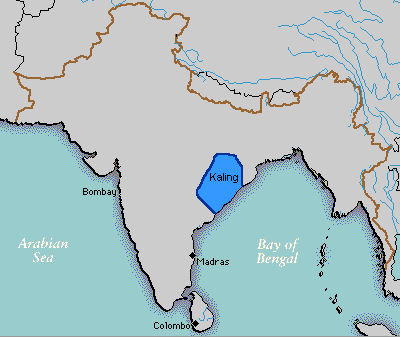
Abb.: Lebensraum der Kaliṅga
[Bildquelle:
Dicrurus macrocerus Vieillot, 1817 - Black Drongo
31 cm
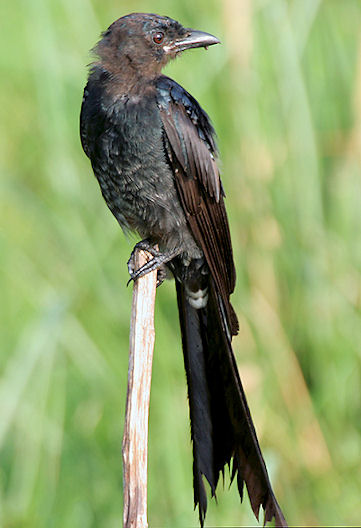
Abb.: कलिङ्गः । Dicrurus macrocerus Vieillot, 1817 - Black Drongo,
Kolkata -
কলকাতা, West Bengal
[Bildquelle: J. M. Garg / Wikimedia. -- GNU FDLicense]
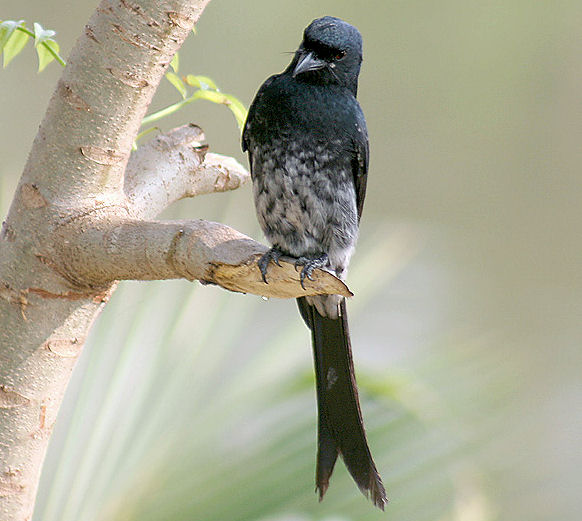
Abb.: धूम्याटः । Dicrurus macrocerus Vieillot, 1817 - Black Drongo,
Kolkata -
কলকাতা, West Bengal
[Bildquelle: J. M. Garg / Wikimedia. -- GNU FDLicense]
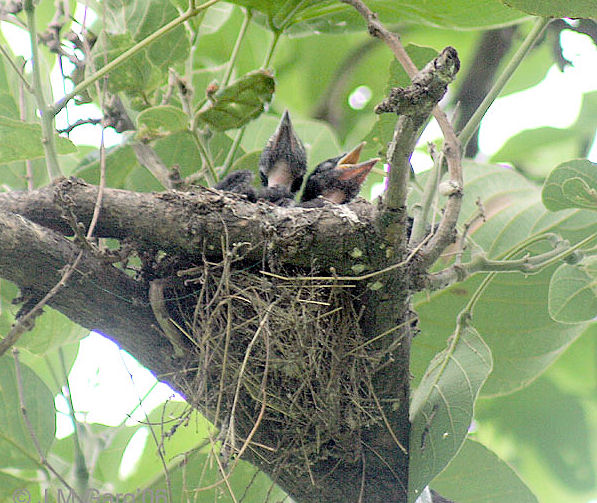
Abb.: भृङ्गौ । Dicrurus macrocerus Vieillot, 1817 - Black Drongo, Kolkata
-
কলকাতা, West Bengal
[Bildquelle: J. M. Garg / Wikimedia. -- GNU FDLicense]
|
"Habitat. The whole of India and Ceylon,
extending to Assam, the Indo-Chinese region, China, Formosa and Burmah. Occurs
also in Java, Siam, Cochin-China, the N.-W. Himalayas, Nepaul, Beloochistan and
Afghanistan. If is found throughout the Punjab, N.-W. Provinces, Oudh, Bengal,
Rajpootana, Central India, Kutch, Guzerat, Konkan, Deccan, Travancore and South
India generally. According to Gates it is a common bird in Burmah and Pegu. In
the latter it is common from October to January. Dr. Armstrong found it common
in the Irrawaddy delta ; Davison found it common in Tennaserim from Moulmein to
Malewoon, and Captain Bingham met with it at Tounghoo.
The King Crow is chiefly found in open
jungle, and seldom or never in forests. It is a conspicuous bird everywhere
about a station. Its presence is readily known simply by its cheerful and pretty
notes. Perched on a telegraph wire, wall, or on a bare branch, its sweet notes
are uttered, not forgetting now and again its rather harsh cry. A couple of
pairs within one's grounds often make their chattering, as if one to another for
half an hour at a time, sound disagreeable. Its loquacity is unsurpassed,
especially in the early morn. It is often seen on the backs of cattle, sheep and
goats when out grazing in company with Acridotheres tristis or ginginianus, the
common crow, and not unfrequently Neophrons.
The food of the King Crow is chiefly insects
of sorts, as grasshoppers, mantises, bees, wasps, ants, dragon flies, moths and
butterflies. I don't know that it has a predilection for anything higher than
members of the Invertebrates. During the breeding season, which lasts from May
to July, March to April, and August and September, according to locality, the
King Crow is very pugnacious. It pursues and drives away every bird it suspects,
even hawks, kites, and crows, especially when the female is sitting for
incubation. It places its nest generally in the fork of the outer branches of a
tree, selecting generally an Acacia. It is cup-shaped and shallow, and made of
fine twigs and grass. In some instances lined outside with cobwebs and inside
with a little hair or feathers. Eggs generally 4 in number, reddish or pinkish
white, prettily streaked, spotted and blotched with brick red or brown."
[Quelle: Murray, James
A.:
The avifauna of British India and its dependencies. -- London :
Trübner, 1888-1890. -- 2 Bde. -- Bd. 1, S. 155.] |
|
"This Drongo Shrike is found throughout the
whole of India and Ceylon, extending through Assam and Burmah into China, and is
to be met with in every part of the country, except in dense and lofty jungle.
It perches generally on some bare branch, whence it can have a good look-out, or
the top of a house or post or telegraph-wire, frequently also on low bushes,
hedges, walls or ant-hills ; and very generally on the backs of cattle, sheep,
or goats, hence one of its popular Telugu names.
It feeds chiefly on grasshoppers and
crickets, which, as Sundeval remarks, appears to be the chief insect food for
birds in India ; also now and then on wasps or bees, hence the Bengal name ; on
dragon-flies, and occasionally moths or butterflies. It generally seizes its
insect prey on the ground, or whips one off a stalk of grain, frequently
catching one in the air ; now and then, when the grasshopper, having flown off,
alights in a thick tuft of grass, the King-crow hovers for a few seconds over
the spot like a Kestrel. When it has seized an insect, it generally, but not
always, returns to the same perch. On an evening, just about sunset, it may
often be observed seated on the top of a tree, taking direct upward flights, and
catching some small insects that take wing at that time. Like most other birds,
when a flight of winged termites takes place, it assembles in numbers to partake
of the feast.
The King-crow obtains his familiar name in
this country from its habit of pursuing Crows and also Hawks and Kites, which it
does habitually ; and at the breeding season, especially when the female is
incubating, with increased vigilance and vigour. If a Crow or Kite approach the
tree in which their nest is placed, the bold little Drongo flies at them with
great speed and determination, and drives them off to a great distance ; but
although it makes a great show of striking them, I must say that I have very
rarely seen it do so, and certainly I have never seen it fix on the back of a
Hawk with claws and beak for some seconds, as Mr. Philipps asserts that he has
seen. Occasionally, others will join the original assailant, and assist in
driving off their common enemy. From this habit the bird has received the name
of Kotwal in some parts of the country. Blyth assures me that he has seen these
birds attack and pursue the little Palm Squirrel. At the pairing season, they
are exceedingly pugnacious : and four or five may not unfrequently be seen
entangled together on the ground, fighting both with beak and claws.
The Drongo is lively, active, and loquacious,
constantly uttering its well known, somewhat harsh, but cheerful cry ; it is one
of the earliest birds to greet the coming morn, and not unfrequently keeping up
an occasional conversation with a neighbour for the greater part of a moonlight
night. I have known people in India who professed to find it monotonous and
disagreeable, and have heard it profanely called the Scotch Nightingale ; but I
confess to liking its cheerful voice, and to hear it herald in the pleasant dawn
of day.
During the breeding season it has a more
pleasing and melodious song, which Sundevall calls a charming song, something
like that of Sylvia trochilus.
The King-crow breeds at various seasons, a
good deal according to the locality ; from March and April in some places, to
August and September in other. It is possible it may have two broods in the
year, but I do not know this. The nest is a slight, shallow structure,
carelessly put together, of a few small twigs and roots, and generally placed in
a rather conspicuous place, on the fork of a branch at no great elevation,
generally without any lining, or sometimes with a few hairs. The eggs, three or
four in number, are reddish-white, with a few largish spots or blotches of
purplish-red, brick-red, or red-brown. It appears to leave some parts of the
country during the rains, for Mr. Elliot states that "it migrates from the
Southern Mahratta country during the monsoon;" but it only retires a short
distance to some more convenient place for breeding.
Its flight in general is undulating, not very
rapid, and performed but with few flappings ; but when it exerts itself after a
Crow it is capable of great speed, and always overtakes its enemy with ease.
Mr. Philipps relates a curious instance of
sagacity or reasoning this bird, once witnessed by himself. Another bird was
pursuing a large locust which the King-crow evidently coveted, for he made one
or two dashes after it, but apparently did not dare to seize it; when he
suddenly gave his cry of alarm, betokening the presence of some bird of prey ;
the original pursuer of the insect quitted the chase, and the King-crow carried
off the locust as his lawful booty.
Mr. Swinhoe relates that he found
this species breeding in company on bamboos in Formosa.
This is the most common and abundant species
of Dicrurus, and is met with over the whole of India, from the font of the
Himalayas to Cape Comorin, and from the Punjab to Arrakan, Burmah, and even to
Java."
[Quelle:
Jerdon, T. C. (Thomas Claverhill) <1811-1872>: The birds
of India. -- Calcutta, 1862. -- Vol 1. -- S. 427ff.] |
2.9.41. Picidae - Woodpecker - Spechte
16. c./d.
kaliṅga-bhṛṅga-dhūmyāṭā
atha syāc chatapatrakaḥ
17. a./b. dārvāghāṭo
'tha sāraṅgaḥ stokakaś cātakaḥ samāḥ
कलिङ्ग-भृङ्ग-धूम्याटा अथ स्याच् छतपत्रकः ॥१६ ख॥
दार्वाघाटो
ऽथ
सारङ्गः स्तोककश् चातकः समाः ।१७ क।
[Bezeichnungen für
Picidae - Woodpecker - Spechte:]
- शतपत्रक - śatapatraka m.: "Hundertfedriger"
= "Psittacula eupatria, Large Indian Parakeet (Alexandrine Parakeet);
Pavo cristatus, Peacock; various Picidae (Woodpecker)." (Dave,
511)
- दार्वाघाट - dārvāghāṭa m.: "auf Hölzernes
Schlagender" = "a generic term for any of the Picidae (Woodpecker)." (Dave,
498)
|
Colebrooke (1807): "A woodpecker."
Dave (s. 120 ff.) nennt folgende Arten:
-
Mulleripicus pulverulentus Temminck, 1826 - Great Slaty
Woodpecker - Puderspecht
-
Dinopium javanense Ljungh, 1797 - Golden-backed Woodpecker
- Feuerrückenspecht
-
Picumnus innominatus Burton, 1836 - Speckled Piculet -
Tüpfelzwergspecht
-
Sasia ochracea Hodgson, 1836 - Rufous Piculet - Rötelmausspecht
Mulleripicus pulverulentus Temminck, 1826 - Great Slaty Woodpecker -
Puderspecht
51 cm
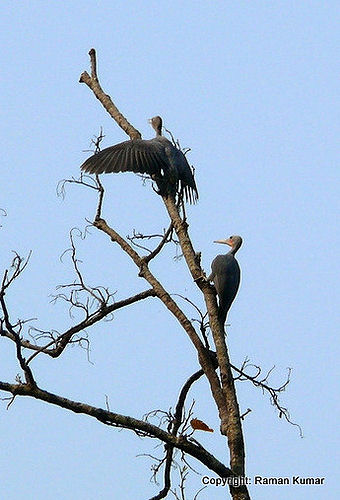
Abb.: दार्वाघाटः । Mulleripicus pulverulentus Temminck, 1826 - Great
Slaty Woodpecker - Puderspecht, Ramnagar forest, near Corbett National Park,
Uttarakhand
[Bildquelle: raman. --
http://www.flickr.com/photos/cyornis/3870218401/. -- Zugriff am 2010-12-18.
-- Creative
Commons Lizenz (Namensnennung, keine kommerzielle Nutzung, share alike)]
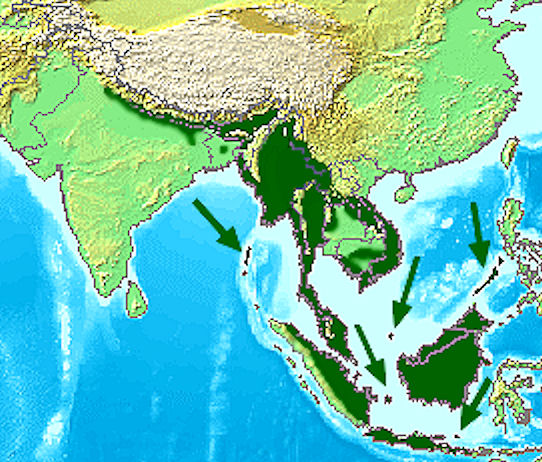
Abb.: दार्वाघाटः । Lebensraum von Mulleripicus pulverulentus
Temminck, 1826 - Great Slaty Woodpecker - Puderspecht
[Bildquelle: Scops / Wikipedia. -- GNU FDLicense]
|
"Habitat. British Burmah, in Pegu, Arracan,
the Karin hills and Tenasserim. It extends southwards through the
Malay Peninsula to Sumatra, Java, Borneo, and Cochin-China.
Northwards it is recorded from the Khasia hills, and it is said to
occur at the foot of the Himalayas, in Oudh and Nepaul. Captain
Bingham is said to have found the nest of this great Slaty
Woodpecker, one of the Oriental giants of the family, in Tenasserim
during April. Eggs, two in number only, white and glossy."
[Quelle: Murray, James A.:
The avifauna of British India and its dependencies. -- London :
Trübner, 1888-1890. -- 2 Bde. -- Bd. 2, S. 451.] |
|
"This large Woodpecker has been found within
our province only in the Dehra Doon ; but it is stated to have been
seen at Darjeeling. It inhabits Arrakan and Burmah, extending down
the coast to Malaccca, Java, and other islands of Malayana. It is
the largest of Oriental Woodpeckers."
[Quelle: Jerdon, T. C.
(Thomas Claverhill) <1811-1872>: The birds of India. --
Calcutta, 1862. -- Vol 1. -- S. 284.] |
Dinopium javanense Ljungh, 1797 - Golden-backed Woodpecker -
Feuerrückenspecht
28 cm
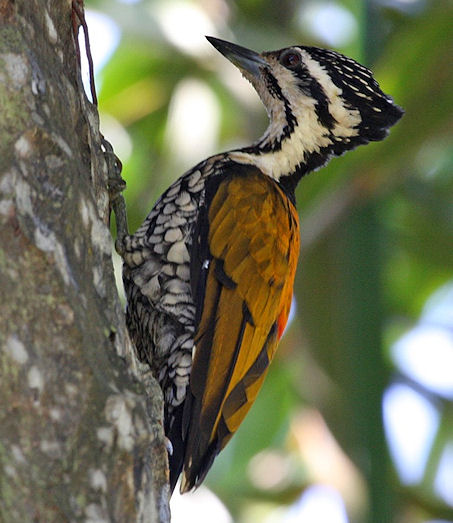
Abb.: शतपत्रकः । Dinopium javanense Ljungh, 1797 - Golden-backed
Woodpecker - Feuerrückenspecht, Singapur
[Bildquelle: Lip Kee. --
http://www.flickr.com/photos/lipkee/3124000727/. -- Zugriff am 2010-12-18.
-- Creative
Commons Lizenz (Namensnennung, share alike)]
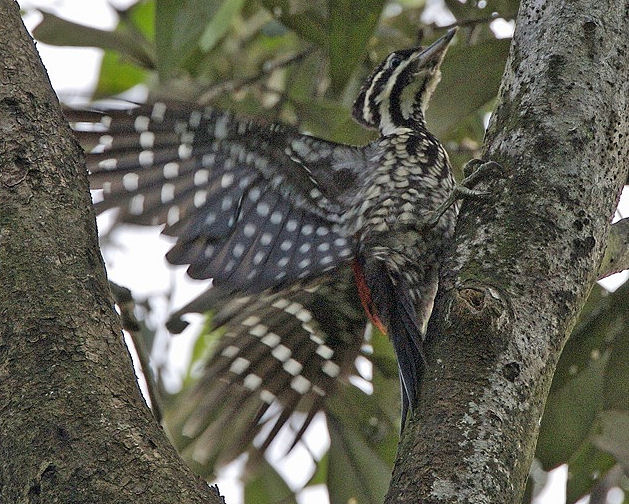
Abb.: शतपत्रकः । Dinopium javanense Ljungh, 1797 - Golden-backed
Woodpecker - Feuerrückenspecht, Singapur
[Bildquelle: Lip Kee. --
http://www.flickr.com/photos/lipkee/1330297431/. -- Zugriff am 2010-12-18.
-- Creative
Commons Lizenz (Namensnennung, share alike)]
|
"Habitat. Throughout the greater part of
India to the foot of the Himalayas, Cashmere, Nepaul and Ceylon. Occurs also in
the Punjab, N.-W. Provinces, Kelat and Afghanistan. Breeds all over the plains
of India during April, May, June and July, in holes in mango, siris, or other
soft-wooded trees, which they excavate themselves. There is no nest except the
fine chips which fall in the act of boring, on which the eggs, generally three
in number, are laid. The eggs are a lengthened pyriform oval, milk-white, and
glossy, In length they vary from 1.0 to 1.2 inch, and in breadth from 0.77 to
0.85 inch. I agree with Mr. Hume, who very properly points out (Str. F. vol. i.
p. 171) that the Sind species, B. dilutus, is not specifically separable."
[Quelle: Murray, James
A.:
The avifauna of British India and its dependencies. -- London : Trübner,
1888-1890. -- 2 Bde. -- Bd. 2, S. 439f.]
|
|
"The Golden-winged Woodpecker is found
throughout the greater part of India and Ceylon, but is replaced in some
districts of the South by the next species. Adams states that it occurs in
Sindh, the Lower Himalayas, and Cashmere ; but with regard to the first-named
province, see B. dilutus, page 297. In Ceylon it inhabits the northern region,
being replaced in the south by another species. It inhabits alike thin
forest-jungle, groves, gardens, and avenues, and is to be found about every
large town or station. It has a loud screaming call, which it frequently utters
as well when perched, as when flying in great undulations from tree to tree. It
breeds, like all other Woodpeckers, in holes in trees, laying three or four
white eggs. Philipps, indeed, states, though of course erroneously, that its
eggs are light green."
[Quelle:
Jerdon, T. C. (Thomas Claverhill) <1811-1872>: The birds of India. --
Calcutta, 1862. -- Vol 1. -- S. 296.]
|
Picumnus innominatus Burton, 1836 - Speckled Piculet -
Tüpfelzwergspecht
10 cm
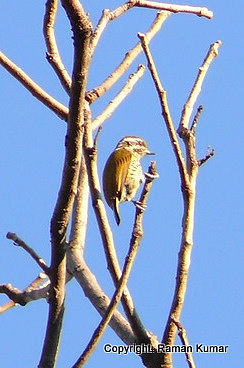
Abb.: दार्वाघाटः । Picumnus innominatus Burton, 1836 - Speckled Piculet -
Tüpfelzwergspecht, Dehradun - देहरादून, Uttarakhand
[Bildquelle: Raman Kumar. --
http://www.flickr.com/photos/cyornis/3870218301/. -- Zugriff am 2010-12-18.
-- Creative
Commons Lizenz (Namensnennung, keine kommerzielle Nutzung, share alike)]
|
"This interesting little bird is found
throughout the Himalayas, and in no other locality that I am aware of. Its range
extends, so far as known, from 3,000 to 6,000 feet or so. It is found in tangled
brushwood, and among dead and fallen trees in damp spots, hunting about among
the decaying bark for various insects. It is said to breed in holes of trees."
[Quelle:
Jerdon, T. C. (Thomas Claverhill) <1811-1872>: The birds
of India. -- Calcutta, 1862. -- Vol 1. -- S. 301.] |
Sasia ochracea Hodgson, 1836 - Rufous Piculet - Rötelmausspecht
9 cm
|
"Habitat. The Himalayas, from Assam to Nepaul
; Cachar, Assam, Khasia hills, Arracan, and British Burmah, in Pegu
and Tenasserim."
[Quelle: Murray, James A.:
The avifauna of British India and its dependencies. -- London :
Trübner, 1888-1890. -- 2 Bde. -- Bd. 2, S. 436.] |
|
"This little bird is found in Nepal and the
Eastern Himalayas, as also in Assam, Sylhet, and Arakan. It is not rare at
Darjeeling, from about 3,000 feet to 6,000 feet or so. Like the last, it chiefly
hunts among the brush-wood, or more especially among fallen and decayed trees,
near the banks of streams. It lives entirely on insects. I never saw it climb on
large trees. It is said to breed in holes of trees."
[Quelle:
Jerdon, T. C. (Thomas Claverhill) <1811-1872>: The birds of India. --
Calcutta, 1862. -- Vol 1. -- S. 302.]
|
2.9.42. Clamator jacobinus Boddaert 1783 - Pied (Crested) Cuckoo -
Jakobinerkuckuck
|
17. a./b.
dārvāghāṭo
'tha sāraṅgaḥ stokakaś cātakaḥ samāḥ
दार्वाघाटो
ऽथ सारङ्गः स्तोककश् चातकः समाः ।१७
क।
[Bezeichnungen für
Clamator jacobinus Boddaert 1783 - Pied (Crested) Cuckoo -
Jakobinerkuckuck:]
-
सारङ्ग - sāraṅga m.: "Gefleckter, Gesprenkelter" = "Clamator jacobinus,
Pied (Crested) Cuckoo." (Dave, 513)
-
स्तोकक - stokaka m.: "Geringer, Tröpfchen" = "Clamator jacobinus,
Pied (Crested) Cuckoo." (Dave, 514)
-
चातक - cātaka m.: Cātaka = "may refer to: Cuculus varius, Common Hawk
Cuckoo (Brainfever Bird); Clamator jacobinus, Pied (Crested) Cuckoo;
also Cuculus (Hierococcyx) sparverioides, Large Hawk Cuckoo,;
Cacomantis passerinus, Plaintive Cuckoo (Gray-bellied Cuckoo);
Cacomantis sonneratii, Banded Bay Cuckoo." (Dave, 494f.)
|
Colebrooke (1807): "Pipiha. Cuculus Radiatus. But it is not
certain wheter the cātaka be not a different bird."
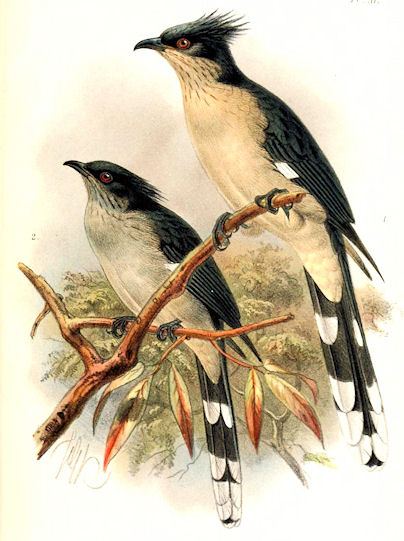
Abb.: सारङ्गः । Clamator jacobinus Boddaert 1783 - Pied (Crested) Cuckoo
- Jakobinerkuckuck, zwei Unterarten
[Bildquelle: John Gerrard Keulemans (1842-1912) / Wikimedia. -- Public domain]
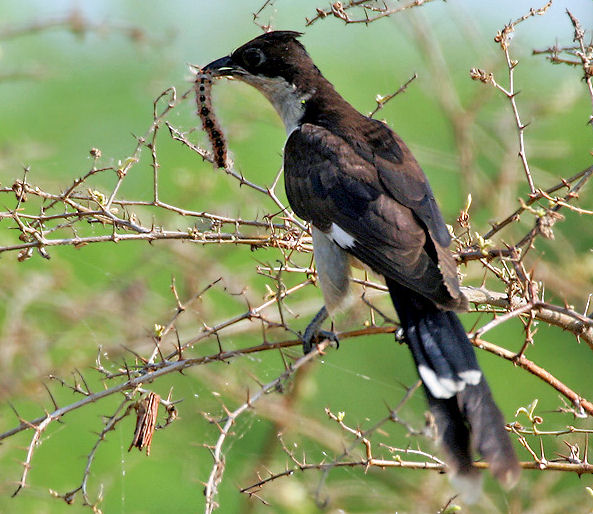
Abb.: स्तोककः । Clamator jacobinus Boddaert 1783 - Pied (Crested) Cuckoo
- Jakobinerkuckuck, Kolleru Lake - కొల్లేరు సరస్సు,
Andhra Pradesh
[Bildquelle: J. M. Garg / Wikimedia. -- GNU FDLicense]
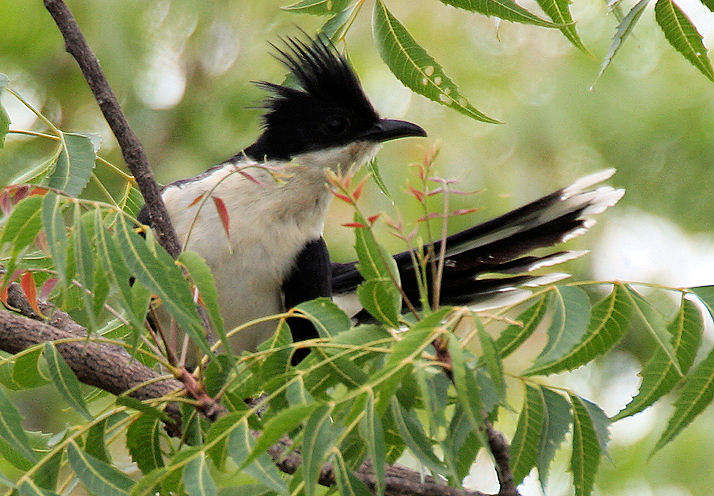
Abb.: स्तोककः । Clamator jacobinus Boddaert 1783 - Pied (Crested) Cuckoo
- Jakobinerkuckuck, Hyderabad
- హైదరాబాద్,
Andhra Pradesh
[Bildquelle: J. M. Garg / Wikimedia. -- GNU FDLicense]
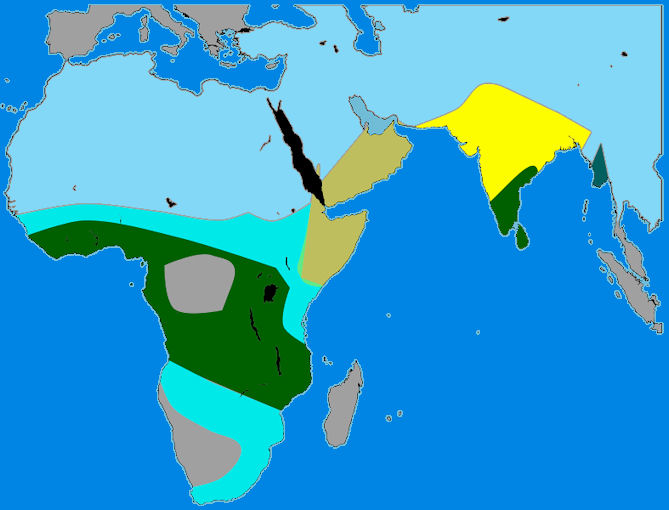
Abb.: सारङ्गः । Lebensräume von Clamator jacobinus Boddaert 1783 - Pied
(Crested) Cuckoo - Jakobinerkuckuck (dunkelgrün: das ganze Jahr; gelb: Sommer;
blau: Winter; creme: nur auf Durchzug)
[Bildquelel: L Shyamal / Wikipedia. -- Public domain]
|
"Habitat. Throughout India to Nepaul. Common
in Central and Southern India, Bengal, Upper Pegu and Ceylon, rare on the
Malabar Coast. In Sind, Kutch, Kattiawar, Rajputana and North Guzerat, and in
fact wherever it is found, it lays according to the breeding season of the
various Babblers, in whose nests it deposits its eggs, from January to July. The
eggs, like those of the Malacocirci, are a spotless sky blue, and highly glossy,
round ovals, varying in length from 0.9 to 0.98 inch, and in breadth from 0.72
to 0.82 inch."
[Quelle: Murray, James
A.:
The avifauna of British India and its dependencies. -- London :
Trübner, 1888-1890. -- 2 Bde. -- Bd. 2, S. 417.] |
|
"This Pied Cuckoo is found over all India,
being rare on the Malabar coast, common in the Carnatic, and not uncommon
throughout Central India to Bengal, where it is only at all common in the rains.
It is more abundant in Upper Pegu than anywhere else that I have observed it. I
mention this, because Mr. Blyth was informed that it was rare on the Eastern
side of the Bay of Bengal. I have seen it on the Neilgherries up to 5,000 feet.
It frequents jungles, groves, gardens, hedges and avenues, generally alone,
sometimes in pairs or small parties.
At the breeding season it is very
noisy, two or three males (apparently) often following a female,
uttering their loud peculiar call, winch is a high pitched wild
metallic note. It utters this very constantly during its flight,
which is not rapid, from one tree to another, and occasionally at a
considerable height. As Mr. Blyth has remarked, it does not at all
affect concealment, perching often on a bare branch, or on the top
of a bush, and not unfrequently alighting on the ground.
It feeds on insects, chiefly mantides,
grasshoppers, caterpillars, &c. The female lays her egg usually in the nest of
the Malacocerci. I found a young one in the nest of M. griseus, in a thick
Euphorbia hedge at Coimbutore ; and Layard, in Ceylon, found a pair of the
Malacocerci of Ceylon, feeding a young one. Theobald also obtained the egg from
the nest of M. caudatus ; and Blyth from that of M. bengalensis : it is deep
greenish-blue, and bluntly oval at both ends. Latham mentions that it is said to
lay its egg in the nest of tire Chatarrhaea, Malacocercus bengalensis.
This bird, remarks Mr. Phillips, makes a
great figure in Hindu poetry, under the name of Chatak."
[Quelle:
Jerdon, T. C. (Thomas Claverhill) <1811-1872>: The birds
of India. -- Calcutta, 1862. -- Vol 1. -- S. 340f.] |
2.9.43. Gallus gallus Linnaeus, 1758 - Red Junglefowl -
Bankivahuhn
|
17. c./d. kṛkavākus tāmracūḍaḥ kukkuṭaś caraṇāyudhaḥ
कृकवाकुस् ताम्रचूडः कुक्कूतश् चरणायुधः ॥१७ ख॥
[Bezeichnungen für
Gallus gallus Linnaeus, 1758 - Red Junglefowl - Bankivahuhn:]
-
कृकवाकु - kṛkavāku m.: wohl "Kräher" = "Gallus
gallus, Red Junglefowl." (Dave, 490)
- ताम्रचूड - tāmracūda m.: "der einen
kuperroten Schopf hat" = "tāmra-cūḍa cf. carma-cūḍa" "carmacūḍa, refers to
two species of Junglefowl: Gallus gallus, Red Junglefowl (Common or
Wild Cock); Gallus sonneratii, Grey Junglefowl." (Dave 494)
- कुक्कूत - kukkuṭa m.: Kukkuṭa = "Gallus
gallus, Red Junglefowl (Common or Wild Cock)." (Dave 489)
- चरणायुध - caraṇāyudha m.: "dessen Waffe
seine Füße sind"
|
Colebrooke (1807): "A gallinaceous fowl."
Gallus gallus Linnaeus, 1758 - Red Junglefowl - Bankivahuhn
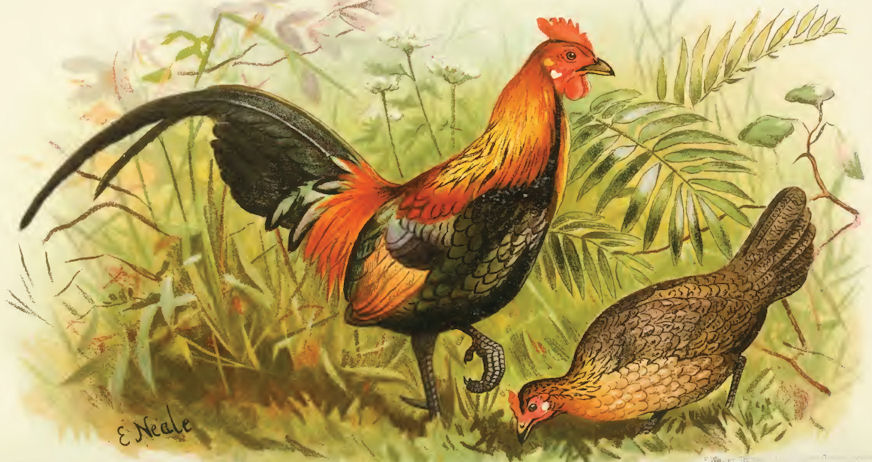
Abb.: कुक्कूतौ
।
Gallus gallus Linnaeus, 1758 - Red Junglefowl - Bankivahuhn
[Bildquelle: Indian sporting birds. -- 1915.]
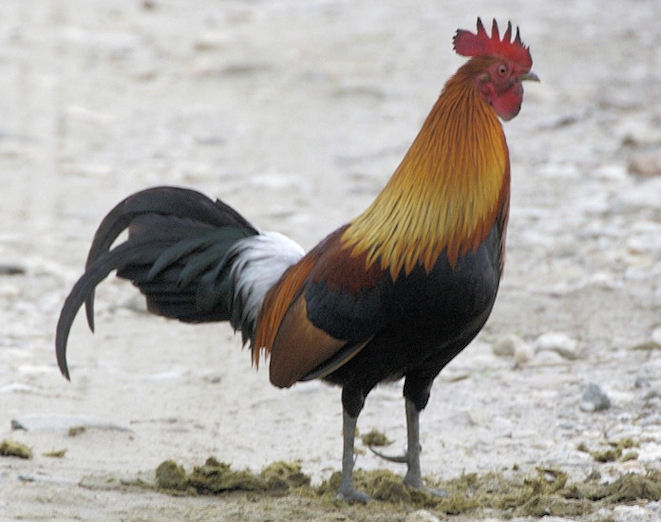
Abb.: चरणायुधः
।
Gallus gallus Linnaeus, 1758 - Red Junglefowl - Bankivahuhn, Hahn,
Kaziranga National Park - কাজিৰঙা ৰাষ্ট্ৰীয়
উদ্যান, Assam
[Bildquelle: Lip Kee. --
http://www.flickr.com/photos/lipkee/2423589442/. -- Zugriff am 2010-12-19.
-- Creative
Commons Lizenz (Namensnennung, share alike)]
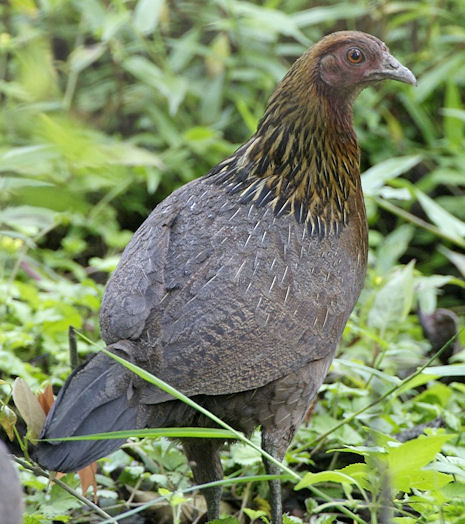
Abb.: Gallus gallus Linnaeus, 1758 - Red Junglefowl - Bankivahuhn, Henne,
Kaziranga National Park - কাজিৰঙা ৰাষ্ট্ৰীয়
উদ্যান, Assam
[Bildquelle: Lip Kee. --
http://www.flickr.com/photos/lipkee/2423589442/. -- Zugriff am 2010-12-19.
-- Creative
Commons Lizenz (Namensnennung, share alike)]
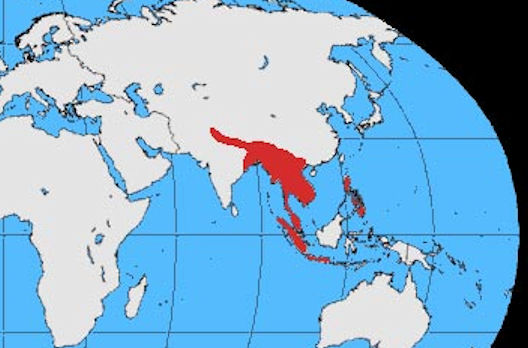
Abb.: Lebensraum von Gallus gallus Linnaeus, 1758 - Red Junglefowl -
Bankivahuhn
[Bildquelle: Kristof vt
|
"Habitat. Himalayas, in the lower ranges, the
Dhoons, Terais, and sub-montane districts. The whole of Assam, Oudh, Central and
N.-W. Provinces, Eastern Bengal, including the Sunderbuns, Arracan, Pegu,
Tenasserim ; all the hilly portions of Western Bengal and Northern and Central
Provinces. Southwards and eastwards, it occurs north of the Godavery, Orissa,
the Tributary Mehals, Ganjam, Vizagapatam, Joonaghur, Nowagur, Jeypore. There is
no description of jungle from which it is absent. In the dry, level, alluvial
plains and semi-deserts of Upper India it is absent. It is very partial to
bamboo jungle, broken ground and ravines with dense vegetation. It breeds from
January to July, according to locality. Eggs, a pale yellowish, café au lait
colour, 8 to 12 in number."
[Quelle: Murray, James
A.:
The avifauna of British India and its dependencies. -- London :
Trübner, 1888-1890. -- 2 Bde. -- Bd. 2, S. 546.] |
|
"The well known Jungle-fowl is found from the
Himalayas southwards, on the west of India, as far at all events, as the range
of Vindhian hills ; and as I have been informed by Mr. W. Blanford since the
above remarks were penned, also south of the Nerbudda on the Raj-peepla hills.
Col. Sykes' variety found in the Western Ghats with much red in its plumage must
be this species, but it is to be wished he had noted the particular locality. On
the east, it occurs through Central India and the Northern Circars to near the
north Bank of the Godavery. I have heard of its having been killed even south of
this, at Cummum, but I cannot speak positively on this head. I have not seen it
myself further south than the banks of the Indrawutty, not far from its junction
with the Godavery, and there both this species and the next were heard crowing a
few yards from each other. I shot one bird, an undoubted hybrid between the two
races. In Central India, this Jungle-fowl is rare, especially towards the
Western portion, at Jubbulpore, Saugor, Mhow, &c., but it is very abundant to
the East, and particularly so in the Northern Circars. It is not uncommon, too,
in the Rajmahal hills, extending to the south bank of the Ganges. Towards the
North-west it occurs in the range of hills South of Cashmere, and to the West of
Jummoo, but is rare there, though common in the lower ranges near Simla, and
thence along the Himalayas to Assam, Sylhet, Chittagong and Burmah. Malayan
specimens are decidedly darker in tint, and have the ear-coverts rufous, and
perhaps may be considered to be a distinct race or species, which, in that case,
would bear Temminck's name, Bankiva. This race appears to extend over many of
the Malayan islands, as far as Timor, at all events; and Mr. Blyth drew my
attention to the statement of Jungle-fowl occurring in the Bonin islands.
Certain pale-colored birds from the lower Himalayan ranges were noticed in the
Ann. and Mag. Nat. Hist., Vol. XX., p. 389.
The Jungle-fowl is very partial to Bamboo
jungle, but is found as well in lofty forests and in dense thickets. When
cultivated land is near their haunts, they may, during the harvest season and
after the grain is cut, be seen morning and evening in the fields, often in
straggling parties of ten to twenty.
Their crow which they give
utterance to morning and evening, all the year round, but especially
at the pairing season, is quite like that of a Bantam cock, but
shorter, and never prolonged as in our domestic cocks.
The hen breeds from January to
July, according to the locality, laying eight to twelve eggs, of a
creamy white color, often under a bamboo clump, or in some dense
thicket, occasionally scraping a few leaves or dried grass together
to form a nest. Sooner or later after the breeding season is over,
the neck hackles of the male sometimes fall off, and are replaced by
short blackish grey feathers.
Where detached clumps of Jungle or small
hills occur in a jungly district where these Fowl abound, very pretty shooting
can be had by driving them by means of dogs and beaters ; and in travelling
through a forest country, many will always be found near the roads, to which
they resort to pick up grain from the droppings of cattle, &c. ; dogs will often
put them up when they at once fly on to the nearest trees. Young birds, if kept
for a few days, are very excellent eating, having a considerable game flavour."
[Quelle: Murray, James
A.:
The avifauna of British India and its dependencies. -- London :
Trübner, 1888-1890. -- 2 Bde. -- Bd. 2, S. 537ff.] |
Gallus sonneratii Temminck, 1813 - Grey Junglefowl - Sonnerathuhn
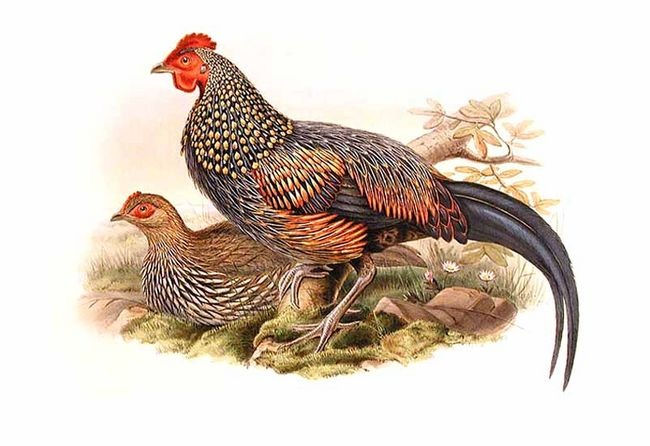
Abb.: ताम्रचूडः । Gallus sonneratii Temminck, 1813 - Grey Junglefowl -
Sonnerathuhn
[Bildquelle: John Gould <1804 – 1881> / Wikipedia. -- Public domain]
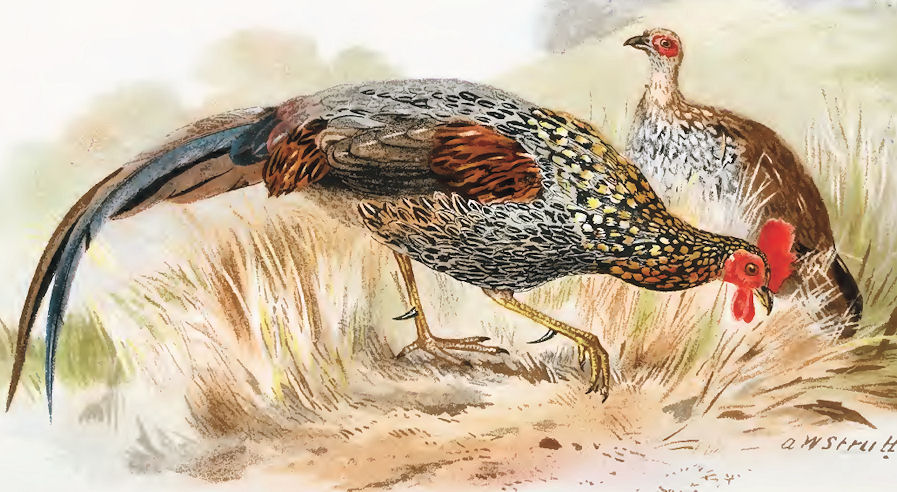
Abb.: ताम्रचूडः । Gallus sonneratii Temminck, 1813 - Grey Junglefowl -
Sonnerathuhn
[Bildquelle: Indian sporting birds. -- 1915.]
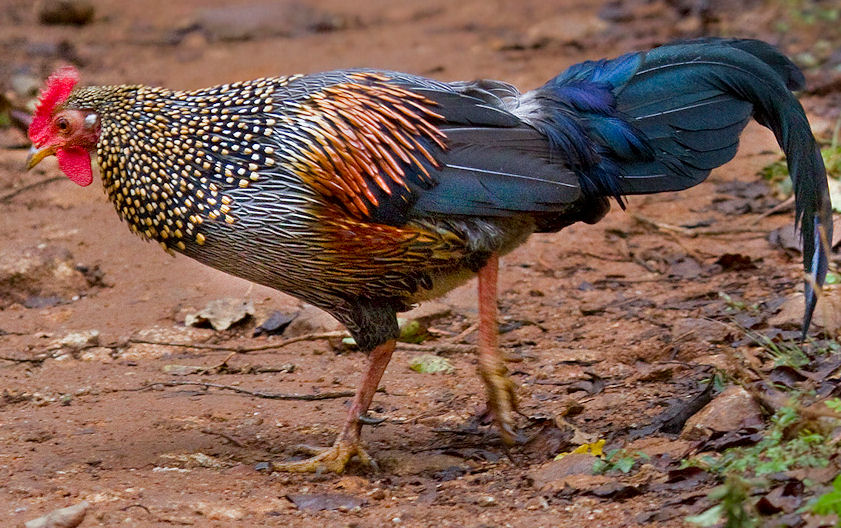
Abb.: ताम्रचूडः । Gallus sonneratii Temminck, 1813 - Grey Junglefowl -
Sonnerathuhn, Punajur State Forest, Karnataka
[Bildquelle:
Tarique Sani. --
http://www.flickr.com/photos/tariquesani/5345784046/. -- Zugriff am
2011-01-18. --
Creative
Commons Lizenz (Namensnennung, keine kommerzielle Nutzung, share alike)]
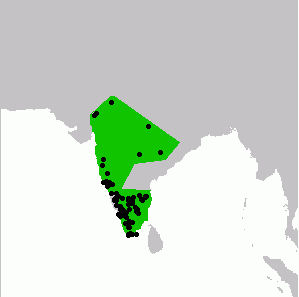
Abb.: ताम्रचूडः । Lebensräume und aktuelle Beobachtungen
(schwarze Punkte) von Gallus sonneratii Temminck, 1813 - Grey Junglefowl
- Sonnerathuhn
[Bildquelle: Shyamal / Wikipedia. -- Public domain]
|
"Gallus Sonnerati, Tem.,
Pl. Col. 232, 233; Jerd., B. Ind. iii. p. 539, No. 813; Elliot, Mon.
Phas. ii. pl. 34 ; Hume, Nests and Eggs Ind. B. p. 531 ; id., Str.
F. iv. pp. 5, 404; Hume and Marsh., Game Birds i. p. 231, pl.
The GREY JUNGLE FOWL.
[...]
Habitat. Throughout the peninsula
of India in suitable localities, extending northwards in the Central
Provinces to Puchmurree, and on the west as far north as Mount Abu.
It ascends the Neilgherries to 5,000 feet. Breeds wherever found in
March and April, making a nest in woods on the ground. Eggs, 7 to
13, dirty white or buff colour, from 1.7 to 2.05 inches in length,
and from 1.35 to 1.5 inches in breadth."
[Quelle: Murray, James A.:
The avifauna of British India and its dependencies. -- London : Trübner,
1888-1890. -- 2 Bde. -- Bd. 2, S. 546f.]
|
|
"Gallus Sonneratii, Temminck.
[...]
The Grey Jungle-fowl.
[...]
This handsome Jungle-fowl is
found in Southern India only, extending on the east coast to a
little north of the Godavery, inCentral India to the Pachmarri or
Mahadeo hills, north of Nagpore, and on the west coast to the
Rajpeepla hills, where it meets the Red Jungle-fowl. Its occurrence
on the Pachmarri hills is most probably its eastern extension from
the Western Ghats and the Kajpeepla hills, and it will probably be
found all along the Sathpoora range. I do not know of its occurrence
east of the Mahadeo hills, till the neighbourhood of the lower part
of the Godavery is reached. It is very abundant on the Malabar
Coast, especially in the more elevated districts, as in the Wynaad,
and it ascends to the summit of the Neilgherries ; it is also common
in suitable localities on the Eastern Ghats, and in the various
isolated ranges of hills in the south of India. It is not rare in
the Naggery hills near Madras, and is constantly brought for sale to
the Madras market.
Like the last, it is particularly partial to
bamboo jungles. Early in the morning, throughout the Malabar Coast, the Wynaad,
&c.. Jungle-fowl may always be found feeding on the roads, and, with dogs, you
are certain of getting several shots on the road side, the birds perching at
once on being put up by dogs. In some districts where they can be beaten out of
the woods, and especially on the Neilgherries, very pretty shooting is to be had
at this Jungle-cock, the sharply defined woods, or 'sholas' as they are called,
being well adapted to being beaten for game. The Hen lays from February to May,
generally having from seven to ten eggs, of a pinky cream colour, under a bamboo
clump. The call of the Cock is very peculiar, being a broken and imperfect kind
of crow, quite unlike that of the Red Jungle-cock, and impossible to describe.
When taken from the jungles they are more wild and not so easily domesticated as
the Red Jungle-fowl ; but they have bred in confinement with Hens of the common
breed. I have already noticed the occurrence, in a wild state, of hybrids
between this and the Red Jungle-fowl.
Ceylon possesses a separate species of
Jungle-fowl, Gallus Stanleiji, Gray, (G. Lafayetti, Lesson ; lineatus, Blyth),
something like Bankiva, but red beneath ;"
[Quelle:
Jerdon, T. C. (Thomas Claverhill) <1811-1872>: The birds
of India. -- Calcutta, 1862. -- Vol 2,2. -- S. 539f.] |
2.9.44. Spatzenähnliche - Sparrow-like birds
18. caṭakaḥ kalaviṅkaḥ syāt tasya strī caṭakā tayoḥ
pumapatye cāṭakeraḥ stryapatye caṭakaiva hi
चटकः कलविङ्कः स्यात् तस्य स्त्री चटका तयोः ।
पुमपत्ये चाटकेरः स्त्र्यपत्ये चटकैव हि ॥१८॥
[Bezeichnungen für Spatzenähnliche:]
-
चटक - caṭaka m.: Caṭaka = "birds in general; small
birds, esp. House Sparrow, Finches, Buntings, etc.; Hirundinidae
(Swallow) and Apodidae (Swift)." (Dave, 494)
- कलविङ्क - kalaviṅka m.: (zu kala 3: zart
tönend) = "a generic term for Sparrow-like birds, with a sweet voice;
Turdus boulboul, Grey winged Blackbird; Turdus merula, (Eurasian)
Blackbird; any of the Passeridae subfamily Ploceinae (Weaver);
Galerida cristata, Crested Lark; Copsychus saularis, (Oriental)
Magpie Robin; Copsychus malabaricus, (White-rumped) Shama;
Pyrrhula erythrocephala, Red-headed Bullfinch; other birds of the genus
Pyrrhula
(Bullfinch); Pyrrhoplectus epauletta, Gold-headed Black Finch
(Gold-naped Finch)." (Dave, 487)
Das Weibchen heißt चटका - caṭakā f.
Ihre männlichen Nachkommen nennt man चाटकेर - cātakera m.
Die weiblichen Nachkommen nennt man चटका - caṭakā f. |
Colebrooke (1807): "A sparrow." [b:] "Its female." [c/d:]
"their offspring male and female."
Hierher gehören u. a.:
Gattung Passer
-
Passer domesticus Linnaeus, 1758 -
House Sparrow - Haussperling / Spatz
-
Passer hispaniolensis Temminck, 1820 -
Spanish Sparrow - Weidensperling
-
Passer montanus Linnaeus, 1758 - Eurasian
Tree Sparrow - Feldsperling
-
Passer pyrrhonotus Blyth, 1845 -
Sind Sparrow - Dschungelsperling: Sindhi جھركي
-
Passer rutilans Temminck, 1835 - Russet
Sparrow - Rötelsperling:
-
Passer moabiticus Tristram, 1864 -
Dead Sea Sparrow - Moabsperling: Wikipedia
Gattung Petronia - Steinsperlinge
-
Petronia xanthocollis Burton, 1838 -
Chestnut-shouldered Petronia - Gelbkehlsperling
-
Petronia petronia Linnaeus, 1766 -
Rock Sparrow - Steinsperling
Sowie u. a.
-
Turdus boulboul Latham, 1790 - Grey winged Blackbird -
Bülbülamsel
-
Turdus merula Linnaeus, 1758 - (Eurasian) Blackbird - Amsel /
Schwarzdrossel
-
Alle Arten der Familie Ploceidae - Weaver - Webervögel
-
Galerida cristata Linnaeus, 1758 -
Crested Lark - Haubenlerche
-
Copsychus saularis Linnaeus, 1758 - (Oriental) Magpie Robin -
Dajaldrossel
-
Copsychus malabaricus Scopoli, 1788 - (White-rumped)
Shama - Schama
-
Pyrrhula erythrocephala Vigors, 1832 - Red-headed Bullfinch -
Rotkopfgimpel
-
Andere Arten der Gattung Pyrrhula - Bullfinch - Gimpel
-
Pyrrhoplectes epauletta Vigors, 1832 - Gold-headed
Black Finch (Gold-naped Finch) - Maskengimpel
Aus der Fülle der hierher gehörigen Arten können nur einige wenige beispielhaft
vorgestellt werden.
Passer domesticus Linnaeus, 1758 -
House Sparrow - Haussperling / Spatz
15 cm
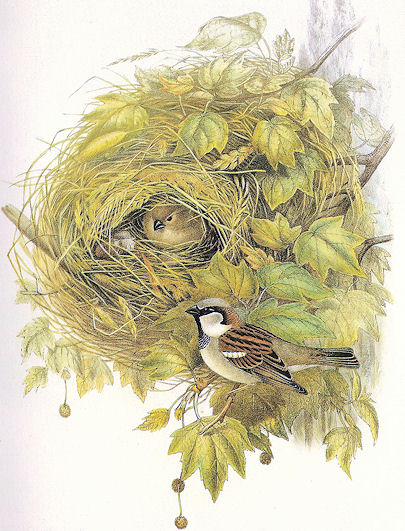
Abb.: चटकश्चाटकेरश्च । Passer domesticus
Linnaeus, 1758 - House Sparrow - Haussperling / Spatz
[Bildquelle: Gould, Birds of Great Britain, 1862 - 1873]
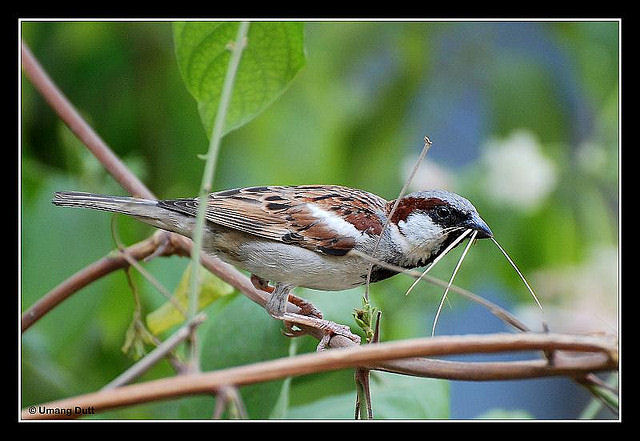
Abb.: चटकः । Passer domesticus Linnaeus, 1758 -
House Sparrow - Haussperling / Spatz, Ahmedabad -
અમદાવાદ, Gujarat
[Bildquelle: Umang Dutt. --
http://www.flickr.com/photos/snapflickr/2674513390/. -- Zugriff am
2010-12-19. --
Creative
Commons Lizenz (Namensnennung, keine kommerzielle Nutzung, keine
Bearbeitung)]
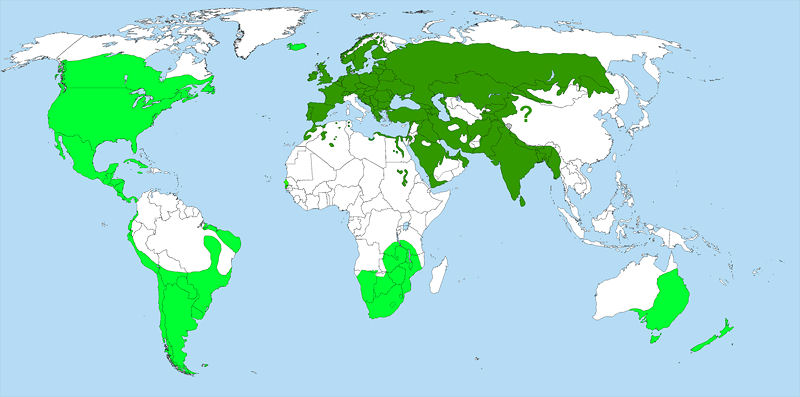
Abb.: चटकः । Lebensräume von Passer domesticus
Linnaeus, 1758 - House Sparrow - Haussperling / Spatz (dunkelgrün:
ursprünglich; hellgrün: durch Menschen eingeführt)
[Bildquelle: Cactus26 / Wikipedia. -- GNU FDLicense]

कलविङ्कः । Klicken! Zirpen eines Passer domesticus
Linnaeus, 1758 - House Sparrow - Haussperling / Spatz
[Quelle der .ogg-Datei: QWerk / Wikimedia. -- GNU FDLicense]
|
"The Sparrow.
To the native of India the
sparrow seems to stand as the type of a thing of naught, an
intrusive feathered fly to be brushed aside but on no account to be
starved or harmed. Our bird is a size smaller than his Western
brother, and is tolerated both by Hindu and Muhammadan. In mosque
courts one sometimes sees pretty troughs made of brick with
divisions for water and food ; and in trees near shrines, or over
the places where devotees sit, earthen saucers are slung with food
and water, all for the sparrow.
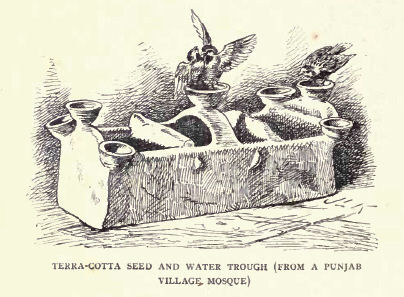
A
Hindu proverb quoted in
Fallon's Dictionary says : "God's birds in God's field ! eat, birds,
eat your bellies full." This pious and kindly word is easily
reconciled in practice with a just appreciation of the essential
triviality and impertinence of the bird. A
large toll is daily taken all
over the country from field and garden, and the equally accessible
grain-dealer's basket. The most devout Hindu alive waves them off
from his stores, for he also must live. But though the sparrow is a
nuisance, it is seldom you hear the bird reckoned a downright
plague, as is undoubtedly the case in America, where it is a type of
the worst kind of immigrant from which the country has suffered. The
reason may be that the same law of protection which leaves the
sparrow free to plunder, is also extended to the hawk, the shrike,
the weasel, and the wild cat, who keep the balance fairly even among
them. Yet. when you listen closely you may hear, in spite of the
vast Oriental tolerance, many an angry word about bird depredations.
London sparrows are said to be
familiar, but when compared with their Indian brethren, their
manners are marked by dignity and cold reserve. Being much given to
marriage, they make a tremendous fuss over their housekeeping, and
when in search of a nesting-place nothing is sacred to them. Above
all, the nest must be sheltered from the heat, and the coolest
places in the land are the interiors of men's houses. An
Englishman's house is the coolest of all, so newly-joined couples,
conversing loudly, are constantly finding their way indoors,
creeping like mice through bath -water channels and under the bamboo
blinds that keep out flies, bringing with them straw and other
rubbish for their untidy beds. When making a morning call, you may
stumble into a darkened drawing-room to find the lady of the house
perched on a chair, madly thrashing up to the roof-beams with a
carriage-whip, while a servant pulls the long cord of an upper
window, crying "sho !"
A bird in church is a rare and delightful incident
to a bored child in the West, but the Indian sparrow perches on the
organ-pipes in full blast, and chatters loudly through the sermon.
Its note is a constant part of the out-door orchestra of Indian
life, accompanying the caw of the crow, the thin squeal of the
squirrel and scream of the kite, the groan of the Persian wheel, the
wailing song of the ox-driver at the well, the creak of the
ungreased cart axle, and the bark of the village dog."
[Quelle: : Kipling, John Lockwood
<1837-1911>:
Beast and man in India : a popular sketch of Indian animals in their
relations with the people. -- London ; New York : Macmillan, 1904.
-- xii, 401 S. : Ill. ; 24 cm. -- S. 47 - 49. -- Online:
http://www.archive.org/details/beastmaninindiap00kipliala. --
Zugriff am 2007-10-25] |
Petronia xanthocollis Burton, 1838 -
Chestnut-shouldered Petronia - Gelbkehlsperling
14 cm
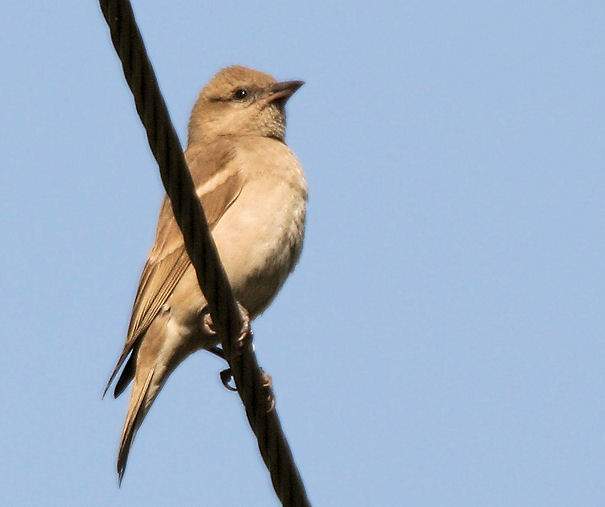
Abb.: चटकः । Petronia xanthocollis Burton, 1838 -
Chestnut-shouldered Petronia - Gelbkehlsperling, Gujarat
[Bildquelle: J. M. Garg / Wikimedia. -- GNU FDLicense]
Ploceus philippinus Linnaeus, 1766 - Baya Weaver -
Bajaweber
15 cm
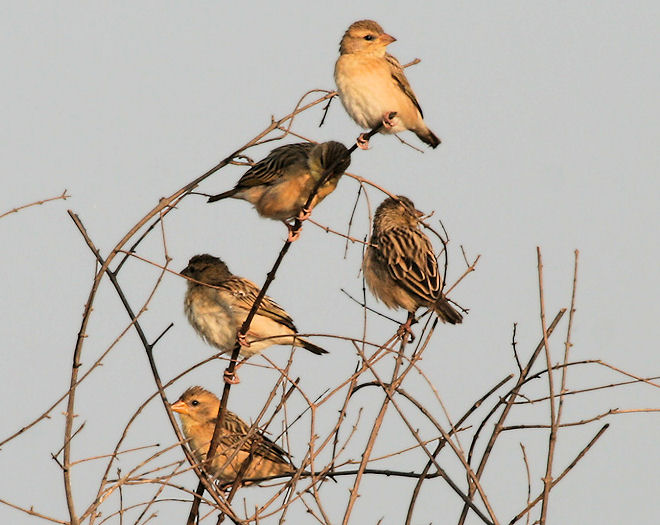
Abb.: कलविङ्काः । Ploceus philippinus Linnaeus, 1766 - Baya Weaver -
Bajaweber, Hyderabad - హైదరాబాద్,
Andhra Pradesh
[Bildquelle: J. M. Garg / Wikimedia. -- GNU FDLicense]
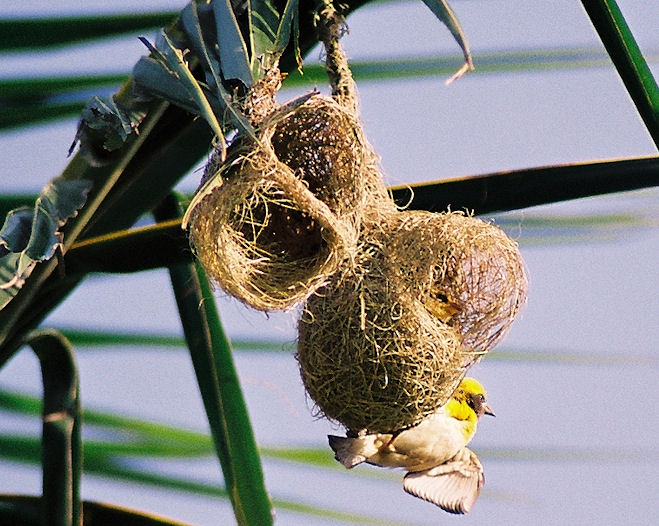
Abb.: कलविङ्कः । Ploceus philippinus Linnaeus, 1766 - Baya Weaver -
Bajaweber, Kotaballappalli, Karnataka
[Bildquelle: Rajeev B / Wikimedia. -- GNU FDLicense]
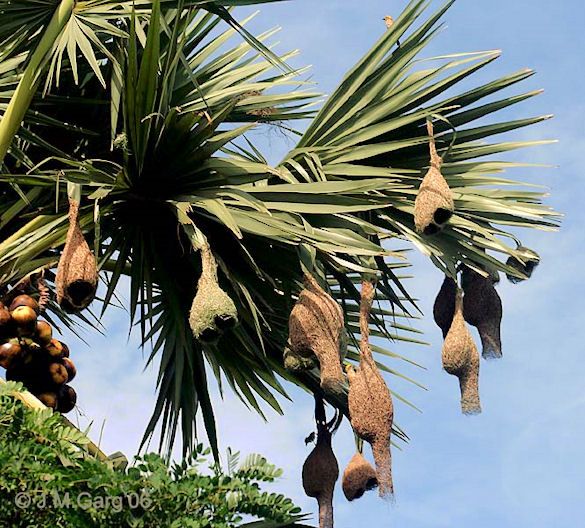
Abb.: Ploceus philippinus Linnaeus, 1766 - Baya Weaver - Bajaweber,
Kolkata - কলকাতা, West
Bengal
[Bildquelle: J. M. Garg / Wikimedia. -- GNU FDLicense]
|
"Habitat. Throughout India to Ceylon, Assam,
Burmah and Nepaul. Common everywhere in Sind with the two next species, as well
as in the Punjab, N.-W. Provinces and Bengal, also Central and Southern India,
the Concan and Deccan, Kutch, Kattiawar, Jodhpore and N. Gujerat. Breeds freely
in company with manyar and bengalensis. Nest non-pensile, being attached lo the
upper stalks of reeds, with the leaves interwoven, and smaller than that of
bengalensis or manyar, less large in the body, and generally with a long and
narrow tubular entrance. The unfinished-like nests are inhabited by the males.
Breeds wherever found from April to June. Eggs white, 3, 4 or 5 in number.
All the species of this genus are taken young
by natives, and taught to perch on the hands and to perform various feats."
[Quelle: Murray, James
A.:
The avifauna of British India and its dependencies. -- London :
Trübner, 1888-1890. -- 2 Bde. -- Bd. 2, S. 338f.] |
|
"The common Weaver-bird is found throughout
the whole of India from Cape Comorin and Ceylon to the foot of the Himalayas,
and extending into Assam, Burmah, and Malayana. It is most abundant in the well
wooded parts of the country, and in the bare table land of the Deccan you may
travel for days without seeing one. It appears to wander about in some
localities, for some observers have stated that it is migratory, but it is
certainly a permanent resident in most parts of the country ; and their roosting
places on certain trees are well known. Grain of all kinds, especially rice and
various grass seeds, form the chief food of the Weaver-bird, and I never
observed it feeding on fruit, as Sykes asserts he has known it do on the fig of
the Banian tree. Whilst feeding, particularly, as well as at other times, the
whole flock keeps up a perpetual chirruping. I have seen it feeding in grain
fields in company with flocks of Emberiza melanocephala ; and Sykes relates that
he has seen it associate with the common Sparrow.
The Baya breeds during the rains, according
to the locality, from April to September, but I am not aware if they ever have
more than one brood. Its long retort-shaped nest is familiar to all, and it is
indeed a marvel of skill, as elegant in its form, as substantial in its
structure, and weather-proof against the downpour of a Malabar or Burmese
Monsoon.
It is very often suspended from the fronds of
some lofty Palm-tree, either the Palmyra, Cocoanut, or Date, but by no means so
universally so as Mr. Blyth would imply, for a Babool (Acacia arabica, or
Vachellia Farnesiana), or other tree will often be selected, in preference to a
Palm-tree growing close by, as I have seen within a few miles from Calcutta en
the banks of the canal. Very often a tree overhanging a river or tank, or even a
large well is chosen, especially, as Tickell says, if it have spreading branches
and scanty foliage. In India I have never seen the Baya suspend its nests except
on trees, but in some parts of Burmah, and more particularly in Rangoon, the
Bayas usually select the thatch of a bungalow to suspend their nests from,
regardless of the inhabitants within. In the cantonment of Rangoon, very many
bungalows may be seen with twenty, thirty, or more of these long nests hanging
from the end of the thatched roof, and, in one house in which I was an inmate,
that of Dr. Pritchard, Garrison Surgeon there, a small colony commenced their
labors towards the end of April, and, in August, when I revisited that station,
there were above one hundred nests attached all round the house ! In India, in
some localities, they appear to evince a partiality to build in the
neighbourhood of villages or dwellings; in other places they nidificate in most
retired spots in the jungle, or in a solitary tree in the midst of some large
patch of rice cultivation.
The nest is frequently made of grass of
different kinds plucked when green, sometimes of strips of plantain leaf ; and
not unfrequently of strips from the leaves of the date palm, or cocoanut ; and I
have observed that nests made of this last material are smaller and less bulky
than those made with grass, as if the little architects were quite aware that
with such strong fibre less amount of material was necessary. The nest varies
much in the length both of the upper part or support, and the lower tube or
entrance, and the support is generally solid from the point whence it is hung
for two or three inches, but varies much both in length and strength. When the
structure has advanced to the spot where the birds have determined the egg
compartment to be, a strong transverse loop is formed, not in the exact centre,
but a little at one side. If then taken from the tree, and reversed, the nest
has the appearance of a basket with its handle, but less so in this than in the
next two species, which have seldom any length of support above. Various authors
have described this loop or bar as peculiar to the male nest, or sitting nest,
whereas it exists primarily in all, and is simply the point of separation
between the real nest and the tubular entrance, and, being used as a perch both
by the old birds and the young (when grown sufficiently), requires to be very
strong. Up to this time both sexes have worked together indiscriminately ; but
when this loop is completed, the female takes up her seat on it, leaving the
cock bird to fetch more fibre and work from the outside of the nest, whilst she
works on the inside, drawing in the fibres pushed through by the male,
re-inserting them in their proper place, and smoothing all carefully.
Considerable time is spent in completing this part of the nest, the egg chamber
being formed on one side of the loop and the tubular entrance at the other ;
after which there appears to be an interval of rest. It is at this stage of the
work, from the formation of the loop to the time that the egg compartment is
ready, that the lumps of clay are stuck on, about which there are so many and
conflicting theories. The original notion, derived entirely, I believe, from the
natives,* was that the clay was used to stick fire-flies on, to light up the
apartment at night. Layard suggests that the bird uses it to sharpen its bill on
; Burgess that it serves to strengthen the nest. I of course quite disbelieve
the fire-fly story, and doubt the other two suggestions. From an observation of
several nests, the times at which the clay was placed in the nests, and the
position occupied, I am inclined to think that it is used to balance the nest
correctly, and to prevent its being blown about by the wind. In one nest lately
examined, there was about three ounces of clay in six different patches.
* See the interesting and almost unique
Natural History by a native, Akbar Ali Khan of Delhi, of the Baya, in the
Asiatic Researches, vol. 2.
It is generally believed that the
unfinished nests are built by the male for his own special behoof,
and that the pieces of clay are more commonly found in it than in
the complete nests. I did not find this the case at Rangoon, where
my opportunities of observing the bird were good, and believe rather
that the unfinished nests are either rejected from some imperfect
construction, weak support, or other reason, if built early in the
breeding season ; or, if late, that they are simply the efforts of
that constructive faculty which appears, at this season, to have
such a powerful effect on this little bird, and which causes some of
them to go on building the long tubular entrance long after the hen
is seated on her eggs.
I have generally found that the Baya lays
only two eggs, which are long, cylindrical, and pure white, but other observers
record a larger number. Sundevall states that he found three in one nest. Layard
says from two to four ; Burgess six to eight ; Tickell six to ten. Blyth thinks
that four or five is the most usual number. From many observations, I consider
two to be the usual number, but have found three occasionally. In those
exceptional instances where six or more eggs have been found, I imagine they
must have been the produce of more than one bird. The Baya, is stated not to use
the same nest for two years consecutively, and this I can quite understand,
without having actually observed it.
The Baya is frequently taken when young,
tamed, and taught to pick up rings, or such like articles, dropped down a well ;
or to snatch the Ticca mark off the forehead of a person pointed out. It is also
taught occasionally to carry a note to a particular place, on a given signal.
Mr. Blyth, in an unpublished paper, has the following interesting account of
some of this bird's performances: "The truth is that the feats performed by
trained Bayas are really very wonderful, and must be witnessed to be fully
credited. Exhibitors carry them about, we believe, to all parts of the country ;
and the usual procedure is, when ladies are present, for the bird, on a sign
from its master, to take a cardamom or sweetmeat, in its bill, and deposit it
between a lady's lips, and repeat this offering to every lady present; the bird
following the look and gesture of its master. A miniature cannon is then
brought, which the bird loads with coarse grains of powder one by one, or more
commonly with small balls of powder made up for the purpose; it next seizes and
skilfully uses a small ramrod; and then takes a lighted match from its master
which it applies to the touch-hole. All this we have personally witnessed in
common with most persons who have resided in or even visited India; and we have
seen the little bird apply the match five or six times successively before the
powder ignited, which it finally did with a report loud enough to alarm all the
crows in the neighbourhood, while the little Baya remained perched on the gun,
apparently quite elated with its performance." Captain Tytler mentions also "the
twirling of a stick with a ball of fire at each end. This the bird turns in
several ways round its head, making luminous circlets in imitation of a native
practice ; the stick being held by the beak in the middle."
In an ordinary cage or aviary, they will
employ themselves constantly, if allowed the chance, in intertwining thread or
fibres with the wires of their prison, merely gratifying the constructive
propensity, with apparently no further object ; unless, indeed, the sexes are
matched, when they breed very readily in captivity ; of course, provided they
are allowed sufficient room, as in a spacious aviary.
This bird has currently passed as P.
philippinus, Auct., but on a reference to the figure in the Pl. Enl. of Buffon,
the type of that species, I am convinced that it refers to the species named
hypoxantha by Daudin."
[Quelle:
Jerdon, T. C. (Thomas Claverhill) <1811-1872>: The birds
of India. -- Calcutta, 1862. -- Vol 2,1. -- S. 344ff.] |
Galerida cristata Linnaeus, 1758
- Crested Lark - Haubenlerche
18 cm
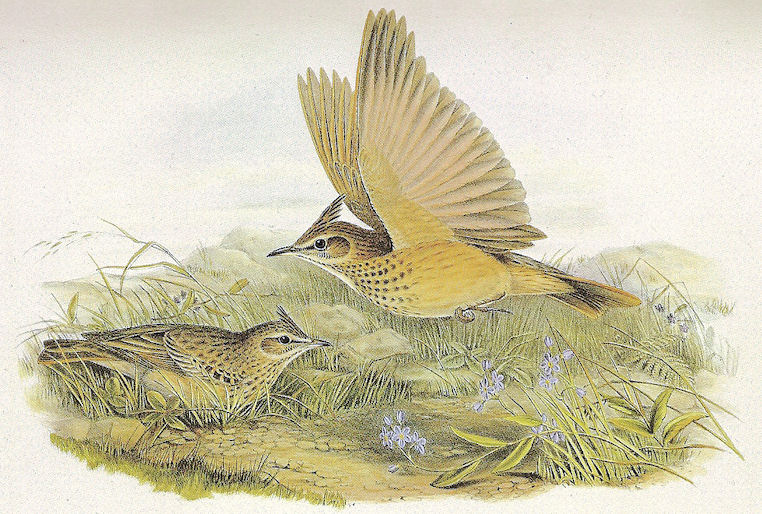
Abb.: कलविङ्कौ । Galerida cristata Linnaeus, 1758
- Crested Lark - Haubenlerche
[Bildquelle: Gould, Birds of Great Britain, 1862 - 1873]
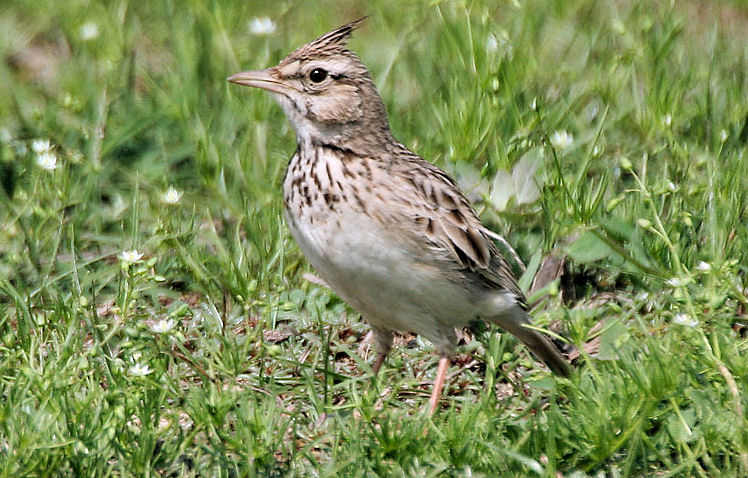
Abb.: कलविङ्कः । Galerida cristata Linnaeus, 1758
- Crested Lark - Haubenlerche, Sultanpur National Park, Haryana
[Bildquelle: J. M. Garg / Wikimedia. -- GNU FDLicense]
|
"Habitat. Universally distributed from sea
level to nearly 8,000 feet above the sea ; S.-E. Europe, Asia, Africa,
throughout India, Persia, Beloochistan, and Afghanistan. Like A. gulgula it
rises in the air to a great height, soaring up to the sun often so high that the
eye cannot follow it, all the while singing, as it advances higher, as if
springing up into the higher regions. This is chiefly noticed during the
breeding season (April and May). It however descends rapidly, but continues its
song till within a few feet of the ground.
As remarked by Mr. Hume, this species is
variable in size and colouration, so much so, that at least half-a-dozen species
have been made by Franklin, Sykes, Jerdon and Blyth. "The examination of a large
series," Mr. Hume says, "proves that it is impossible to draw a line anywhere
between the largest and the smallest examples. A perfect series of the wings
occurs, and as for the difference in tone of plumage, big and little examples
are alike met with amongst the brown, rufous, sandy, grey or desert colour
types.""
[Quelle: Murray, James
A.:
The avifauna of British India and its dependencies. -- London :
Trübner, 1888-1890. -- 2 Bde. -- Bd. 2, S. 361.] |
|
"The crested Lark is widely spread over all
the South of Europe, North Africa, and a great part of Asia ; and it is found
throughout all India, most abundant in the North and North-west. It is rare in
the Carnatic, not found in Malabar, more common in the Deccan, and thence
spreading from Behar in the East, to Sindh and the Punjab, where very common. It
is not known in Bengal, nor in the Himalayas, nor in the countries to the
eastwards.
It prefers dry open sandy plains, or ploughed
land, to grass, wet meadows, or cultivation. It rises in the air singing, though
not so high as A. gulgula, nor is its song so fine. In winter, it may be seen in
small parties, or sometimes in considerable flocks, occasionally on roads and
barren places. Theobald found the nest and eggs, the former, a little grass, in
a hole in the ground, the eggs four, yellowish-white, uniformly freckled with
greyish-yellow and neutral-tint.
It is frequently caged in all
parts of the country, and the bird is kept in darkness by several
layers of cloth wrapped round the cage ; the custom being to wrap an
additional cover round the cage every year. In this state it sings
very sweetly, and learns to imitate most exactly the notes of
various other birds, and of animals, such as the yelping of a dog,
the mewing of a cat, the call of a hen to the chickens, &c., &c.
Examples from different parts of
the country differ somewhat in the depth of colour, some being
lighter than others ; and Mr. Blyth, from a small and caged
specimen, considered that there was a second and smaller race in
India, which he named G. Boysii."
[Quelle:
Jerdon, T. C. (Thomas Claverhill) <1811-1872>: The birds
of India. -- Calcutta, 1862. -- Vol 2,1. -- S. 437f.] |
Copsychus saularis Linnaeus, 1758 - (Oriental) Magpie
Robin - Dajaldrossel
20 cm
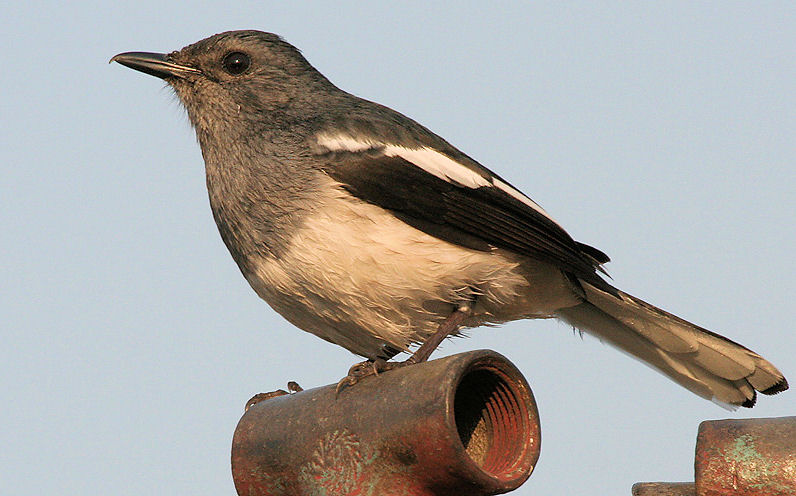
Abb.: कलविङ्कः । Copsychus saularis Linnaeus, 1758 - (Oriental) Magpie
Robin - Dajaldrossel, Weibchen, Kolkata -
কলকাতা, West Bengal
[Bildquelle: J. M. Garg / Wikimedia. -- GNU FDLicense]
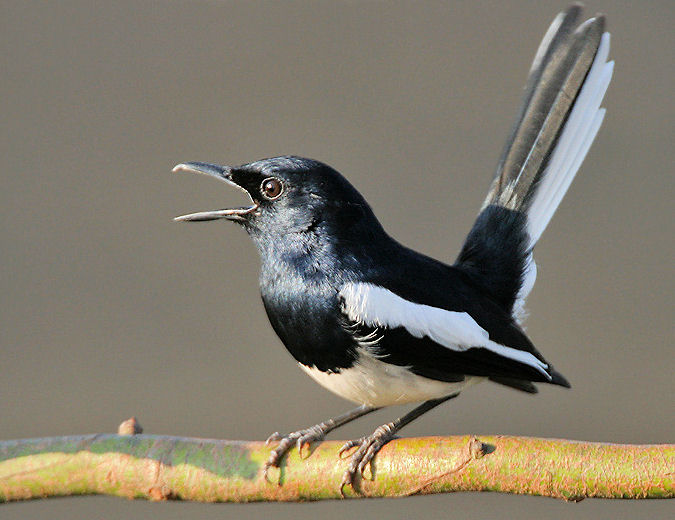
Abb.: कलविङ्कः । Copsychus saularis Linnaeus, 1758 - (Oriental) Magpie
Robin - Dajaldrossel, Männchen, Kolkata -
কলকাতা, West Bengal
[Bildquelle: J. M. Garg / Wikimedia. -- GNU FDLicense]
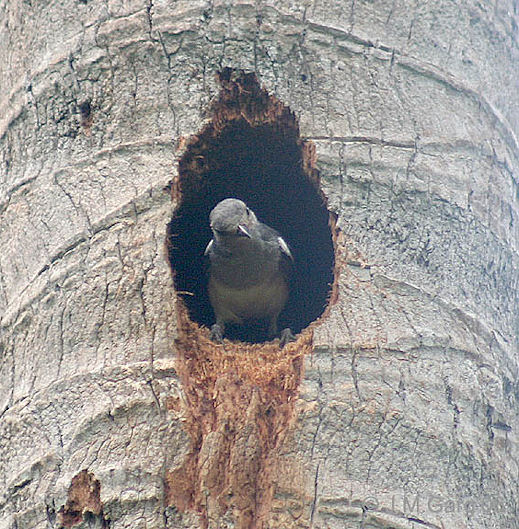
Abb.: कलविङ्कः । Copsychus saularis Linnaeus, 1758 - (Oriental) Magpie
Robin - Dajaldrossel, Weibchen in Nest, Narendrapur -
নরেন্দ্রপুর, West Bengal
[Bildquelle: J. M. Garg / Wikimedia. -- GNU FDLicense]
|
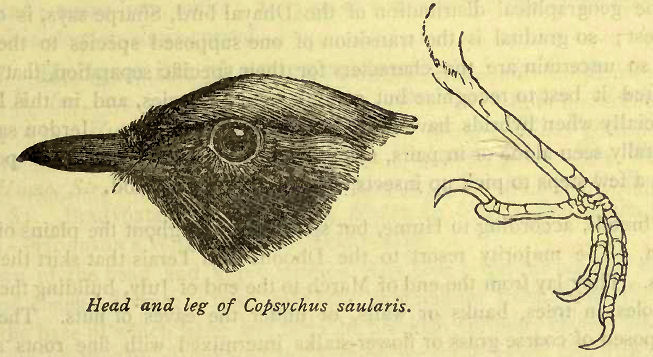
"Habitat. All over India and
Ceylon, eastward to Assam and as far south as Pegu. It is recorded
from Central and South India, also from Nepaul, Darjeeling, Kumaon,
Pegu and the Andamans, and as a race (musicus) Malacca, Penang, Siam
and Java.
The geographical distribution of the Dhayal
bird, Sharpe says, is of great interest ; so gradual is the transition of one
supposed species to the other, and so uncertain are the characters for their
specific separation, that he has deemed it best to recognize but a single actual
species, and in this I agree, especially when hybrids have to be given
consideration to.
Jerdon says it is generally seen
alone or in pairs, usually seeks its prey from a low perch or hops a
few steps to pick up insects, which are its chief food.
It breeds, according to Hume, but sparingly
throughout the plains of Upper India. The majority resort to the Dhoons and
Terais that skirt the Himalayas. They lay from the end of March to the end of
July, building their nests in holes in trees, banks or walls, or under the eaves
of huts. The nest is composed of coarse grass or flower-stalks intermixed with
fine roots and dry tendrils of climbing plants. Eggs, 5 - 6 in number, of a pale
bluish green, thickly spotted and blotched with purplish brown, and showing an
imperfect ring of nearly confluent blotches at the larger end."
[Quelle: Murray, James
A.:
The avifauna of British India and its dependencies. -- London :
Trübner, 1888-1890. -- 2 Bde. -- Bd. 2, S. 66.] |
|
"The Magpie-robin is found throughout all
India, from the Himalayas to Cape Comorin and Ceylon ; and eastwards to Arrakan
and Tenasserim. Hutton says that at Mussooree it occurs up to 5,000 feet. It is
rare near Darjecling, and I never saw it above 3,000 feet. It affects chiefly
wooded districts, but does not inhabit the deep jungles. Towards the South of
India it is less familiar than it is in the North, for in Central India, Bengal
&c., it is often seen feeding close to houses.
It is generally seen alone or in
pairs, usually seeks its prey on the ground from a low perch, often
hopping a few steps to pick up an insect. When it returns to its
perch, it generally elevates its tail and often utters a pleasing
warble. Though it frequently raises and depresses its tail, both
when perched and on the ground, I cannot say that I have observed
the Wagtail-like flirtation of its tail noted by Hodgson, or that it
throws its tail back till it nearly touches its head, as Layard has
seen. Towards the evening it may often be seen near the top of some
tolerably large tree, or other elevated perch, pouring forth its
song.
I have always found its food to
consist of insects of various kinds, small grasshoppers, beetles,
worms, &c. Hodgson asserts that in winter they like unripe vetches,
and such like ; but this is quite opposed to the usual habits of
this group.
It breeds generally in thick
bushes, or hedges ; sometimes in a hole in a bank or tree, and
occasionally in a hole in a wall, or on the rafter of a house. The
nest is made of roots and grass ; and the eggs, four in number, are
bluish white, or pale bluish, with pale brown spots and blotches.
Layard says that the eggs arc bright blue, and Hutton that they are
carneous cream color, but these observers must, I think, have been
mistaken in the identity of the owner of the nest.
The Dayal is often caged, as well for its
song, as for its pugnacious qualities, which, according to Hodgson, are made use
of to capture others. "Fighting these tame birds," says Hodgson, "is a favorite
amusement with the rich (in Nepal), nor can any race of game-cocks combat with
more energy and resolution than do these birds." Latham called it the Dial bird
from its native name, and Linnaeus, apparently thinking that it had some
connection with a sundial, called it Solaris, by lapsus pennae, saularis. I may
here state that in my Catalogue published in 1839, I called it the Magpie-robin,
by which name Mr. Layard says it is now known in Ceylon."
[Quelle:
Jerdon, T. C. (Thomas Claverhill) <1811-1872>: The birds
of India. -- Calcutta, 1862. -- Vol 2,1. -- S. 115f.] |
Pyrrhula nipalensis Hodgson, 1836 - Brown Bullfinch -
Schuppenkopfgimpel
17 cm
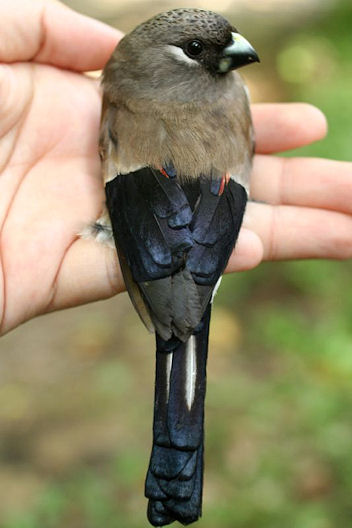
Abb.: कलविङ्कः । Pyrrhula nipalensis Hodgson, 1836 - Brown Bullfinch
- Schuppenkopfgimpel
[Bildquelle:
PeiWen Chang. --
http://www.flickr.com/photos/23032104@N00/892520671/. -- Zugriff am
2010-12-19. --
Creative Commons Lizenz (Namensnennung)]
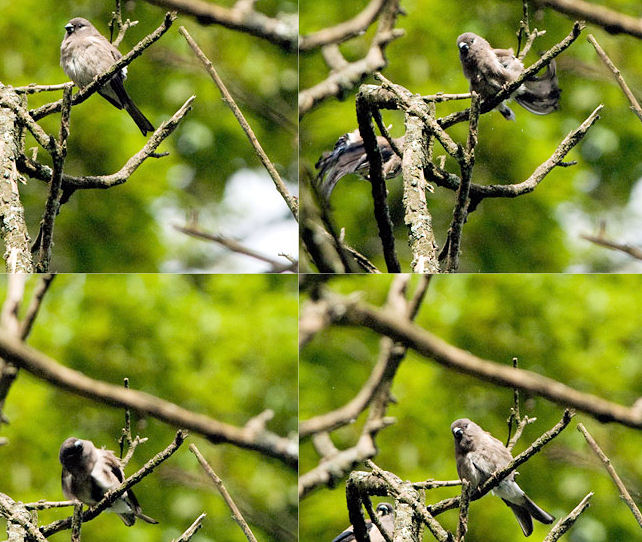
Abb.: कलविङ्कः । Pyrrhula nipalensis Hodgson, 1836 - Brown Bullfinch
- Schuppenkopfgimpel
[Bildquelle: pseudolapiz. --
http://www.flickr.com/photos/pseudolapiz/2621958484/. -- Zugriff am
2010-12-19. --
Creative
Commons Lizenz (Namensnennung, keine kommerzielle Nutzung, share alike)]
| "Habitat. S.-E. Himalayas, Nepaul and Sikkim."
[Quelle: Murray, James A.:
The avifauna of British India and its dependencies. -- London :
Trübner, 1888-1890. -- 2 Bde. -- Bd. 2, S. 325.] |
|
"This plain-colored Bull-finch differs from
the typical species by its firmer plumage, longer and more forked
tail, the feathers of which are slightly truncated. It has been
procured only in the South-east Himalayas, in Nepal, and Sikim,
where it is not very rare in winter, in summer seeking the higher
elevations."
[Quelle:
Jerdon, T. C. (Thomas Claverhill) <1811-1872>: The birds
of India. -- Calcutta, 1862. -- Vol 2,1. -- S. 390.] |

